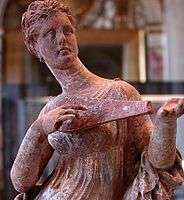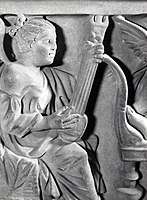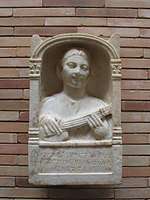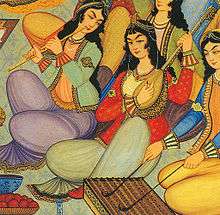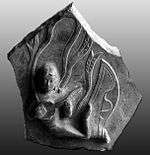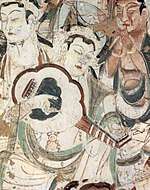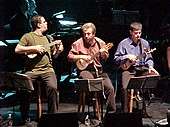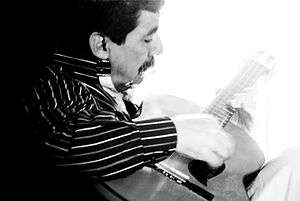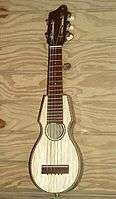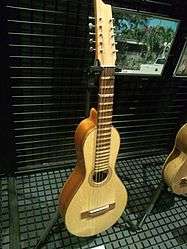History of lute-family instruments
Lutes are stringed musical instruments that include a body and "a neck which serves both has a handle and as a means of stretching the strings beyond the body".[1]
The lute family includes not only short-necked plucked lutes such as the lute, oud, pipa, guitar, citole, gittern, mandore, rubab, and gambus and long-necked plucked lutes such as banjo, tanbura, bağlama, bouzouki, veena, theorbo, archlute, pandura, sitar, Tanbur, setar, but also bowed instruments such as the Yaylı tambur, rebab, erhu, and entire family of viols and violins.[1]
Lutes apparently rose in ancient Mesopotamia prior to 3100 B.C. or were brought to the area by ancient Semitic tribes. The lutes were pierced lutes, long-necked lutes with a neck made from a stick that went into a carved or turtle-shell bowl, the top covered with skin, and strings tied to the neck and instrument's bottom.
Curt Sachs, a musical historian, placed the earliest lutes at about 2000 B.C. in his 1941 book The History of Musical Instruments.[2] This date was based the archaeological evidence available to him at that time. The discovery of an apparent lute on an Akkadian seal, now in the British Museum, may have pushed the known existence of the plucked lute back to c. 3100 B.C.[3]
The lute's existence in art was more plain by the 2330–2000 (the 2nd Uruk period), when the art has sufficient detail to show the instrument clearly. The instrument spread among the Hittites, Elamites, Assyrians, Mari, Babylonians and Hurrians. By c. 1500 the lute spread to Egypt, through conquest, and to Greece by 320 B.C. both through Egypt and eastern neighbors. The lute spread eastward as well. Long lutes today are found from Europe to Japan and south to India.
The short lute developed in Central Asia or Northern India in areas that had connection to Greece, China, India and the Middle East through trade and conquest. The short wood-topped lute moved east to China (as the Pipa) south to India (as the Vina), and west to the Middle East, Africa and Europe as the Barbat and Oud. From these two, and from skin topped lutes known today mainly as rubabs, from and plucked fiddles, instruments developed in Europe.
Europeans had access to lutes in several ways. Foreign sources came in through Byzantium, Sicily and Andalusia. In the non-literate period, they apparently experimented with homegrown instruments which were revealed in documents from the Carolingian Renaissance. This was overwhelmed by incoming instruments and Europeans developed whole families of lutes, both plucked and bowed.
Lute-family instruments penetrated from East and Southeast Asia through Central Asia and the Middle East, through North Africa, Europe and Scandinavia. In modern times, lute-family instruments are used worldwide.
Precursors to lutes, a theory

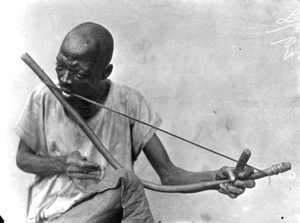
Theory
In theory, families of musical instruments descend from the musical bow.
Henri Breuil surveyed the Trois Frères caves in France and made an engraving that attempted to reproduce a c. 13,000 B.C. cave painting into a black-and-white lithograph engraving.[4] His engraving showed a mysterious figure, a "man camouflaged to resemble a bison", in the midst of a mass of herd-animals, "herding the beasts and playing the musical bow".[4][5][6] The artwork is confused, and those who are trying to reproduce the art in color have had to work to bring out legible images.[5][6] One interpretation of the "magician-hunter" image considers his hunting-bow to be a musical bow, used as a single-stringed musical instrument.[6][7]
Whether the bow in the cave illustration is a musical instrument or the hunting tool in a paleolithic hunt, musicologists have considered whether the bow could be a possible relative or ancestor to chordophones, the lutes lyres, harps and zither families.[8] Curt Sachs said that there was good reason not to consider hunters' bows as likely musical bows.[9] One reason was that the oldest known musical bows were 10 feet long, useless for hunting, and that "musical bows were not associated with hunters' beliefs and ceremonies".[9]
Sachs considered the musical bows important, however. He pointed out that the name for the Greek lute, pandûra was likely derived from pan-tur, a Sumerian word meaning "small bow".[10] He considered this evidence in support of the theory that the musical bow was ancestral to the pierced lute.[10]
The bows used for music required a resonator, a hollowed object like a bowl, a gourd or a musician's mouth, in order to produce audible sound.[9] Although the musical bow could be manipulated to produce more than one tone instruments were developed from it that used one note per string.[9][8] Since each string played a single note, adding strings added new notes for instrument families such as bow harps, harps and lyres.[8] In turn, this led to being able to play dyads and chords.[8] Another innovation occurred when the bow harp was straightened out and a bridge used to lift the strings off the stick-neck, creating the lute.[11]
Theory disputed
This picture of musical bow to harp bow is theory and has been contested. In 1965 Franz Jahnel wrote his criticism stating that the early ancestors of plucked instruments are not currently known.[12] He felt that the harp bow was a long cry from the sophistication of the 4th-century BC civilization that took the primitive technology and created "technically and artistically well-made harps, lyres, citharas and lutes".[12]
Long-necked lutes
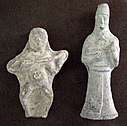
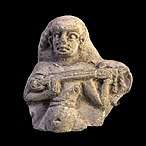

The most ancient lutes had long necks. These survived into the modern era as the tanbur, which Sacks said "faithfully preserved the outer appearance of the ancient lutes of Babylonia and Egypt".[13] Sachs, one of those who created the widespread system of musical instrument classification idea today, categorized long lutes with a "pierced lute" and "long neck lute".[1] The pierced lute had a neck made from a stick that pierced the body (as in the ancient Egyptian long-neck lutes, and the modern African gunbrī).[14] The long lute had an attached neck, and included the sitar, tanbur and tar (dutār 2 strings, setār 3 strings, čatār 4 strings, pančtār 5 strings).[1][13]
Musicologist Richard Dumbrill today uses the word lute more categorically to discuss instruments that existed millennia before the term "lute" was coined.[15] Dumbrill documented more than 3000 years of iconographic evidence for the lutes in Mesopotamia, in his book The Archaeomusicology of the Ancient Near East. According to Dumbrill, the lute family included instruments in Mesopotamia prior to 3000 BC.[3] He points to a cylinder seal as evidence; dating from c. 3100 BC or earlier (now in the possession of the British Museum) the seal depicts on one side what is thought to be a woman playing a stick "lute".[3][16] Like Sachs, Dumbrill saw length as distinguishing lutes, dividing the Mesopotamian lutes into a long variety and a short.[17] His book does not cover the shorter instruments that became the European lute, beyond showing examples of shorter lutes in the ancient world. He focuses on the longer lutes of Mesopotamia, various types of necked chordophones that developed throughout ancient world: Greek, Egyptian (in the Middle Kingdom), Iranian (Elamite and others), Hittite, Roman, Bulgar, Turkic, Indian, Chinese, Armenian/Cilician cultures. He names among the long lutes, the pandura and the tanbur[18]
Experts who study the people from ancient civilizations in Mesopotamia region argue as to which people the long-necked people originated. Candidates include "East Semites" of Akkad, peoples in Elam and "West Semites".[19] The instrument was probably distributed by the Hittites, Hurrians and Kassites, rather than invented by them.[19]
Examples from 2334 to 2000 B.C. (Uruk period 3) exist from Ischali, Eshnunna (Tell Asmar), Kish, Mesopotamia, Iran, Iraq, Tello, Susa.[20] Later examples exist from 2000 to 1500 B.C. (Uruk period 4). Examples were found in Khafage, Mari, Isin or Larsa, Iran, Babylon, Tell Mamabaqat Syria, Susa, and Alaca Huyuk.[20] In period 5 from 1500 to 1000 B.C., the Egyptians acquired the lute and their art also contributed to our knowledge, as well as actual lutes found in graves.
Prehistoric roots in Sumer, westward to Egypt

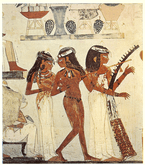
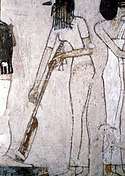
Egypt— The Egyptians acquired the lute with singing and dancing girls, as tribute from conquered territories, shown in a 1422 B.C. painting.[21] The tradition of exchanging female performers between countries was long lived.
China— In China, more than 11000 slaves specializing in entertainment—music dance and instrumentals—had their own section in the capital, Changan, during the Tang Dynasty (618–960 A.D.)[22]
Arabia, Persia and Islamic Countries— The commerce in slaves between the countries of the Near East, accompanied by their instruments, gave music an "international, interoriental character", which blended as Islam spread from the Malayan Archipelago in Asia to Spain.[23] Under both the Umayyads and Abbasids they were "highly accomplished, not only in music, but in other departments of culture" and trained in schools by virtuosi.[24] In the "Days of Idolatry" among the Arabs, singing girls were common, into the era of Muhammad (570–632 A.D.)[25] They were part of "the household of every Arab of social standing", and "attached to the taverns for the entertainment of the visitors".[25] In the 430s A.D., Persian king Bahram Ghur visited the court of the Ghassanids, where he listened to girls from the Byzantine Empire and from Al-Hira sing music from their homes, accompanied by the barbat, a Central Asian instrument.[23] The instruments accompanying the singers "lost their regional character" by the 7th century A.D.[23] It should be pointed out that not all the women singing and playing lutes were slaves. The harem was not part of the Bedouin culture in the days before Muhammed, and free women women "joined in the music of the family or tribal festivities with their instruments".[25] It was a time of the "badawī Arab". A secular people then, for them "love, wine, gambling, hunting, the pleasure of song and romance ... wit and wisdom" were all important.[25]
Sumerians, Babylonians, Kassites, Assyrians, Persians, Greeks all ruled the Mesopotamian area between Tigris and Euphrates rivers where the earliest examples of lutes have survived in clay and stone artwork.[26] Sachs described the Mesopotamian lutes as having "very small bodies, long necks with many frets, two strings attached without pegs and were played with a plectron".[27] The long lute entered Egypt after its conquest of Southwest Asia, when it began receiving tribute in the form of "singing and dancing-girls with their instruments", illustrated in paintings at Tell El-Amarna.[21]
The paintings of the Egyptian lutes are detailed enough to provide a better understanding of ancient long lutes. Furthermore, original lutes survived in tombs, some still with strings attached. The Egyptian pierced-lutes had a carved wooden bowl for the instrument's body, "usually oval", covered with rawhide. A stick which acted as the instrument's neck pierced the instrument's body. The stick was threaded through cuts in the top of the rawhide to the end of the bowl. It was attached to the strings through a "triangular opening cut in the skin" at the bottom of the bowl. Besides being woven through the skin-soundboard, the stick was supported underneath by "wooden crosspieces" that ran crosswise underneath the stick, to the edges of the bowl on either side.[28] The strings were "wound around the top of the handle" and tied with thongs, the tassels visible in some surviving artwork.
Nora E. Scott gave more details about the Egyptian lute's construction, saying that the lute had two bridges, the triangular bridge at the bottom, attached to the stick and protruding through the skin, and another on the neck.[29] The string passed over the second bridge and was tied down to the neck with linen cord to keep its tension.[29] The player tuned the lute by pulling the string tight over the second bridge and tightening the linen cord to hold.[29] The second bridge corresponds in function to the nut on a guitar or mandolin. The soundboard skin could have as many as six soundholes.[29]
Sachs points out one significant difference between the Egyptian lutes and other pierced lutes of the ancient world. The non-Egyptian lutes had a stick handle piercing the bowl on both ends (spike lutes), rather than having one end resting inside the bowl (tang lutes).[28] He also gave consideration to African skin-topped instruments that survived into the 20th century, noting that those in Morocco and Senegambia, such as the gunbri, might be descendants.[28] He said the instruments "degenerated" from the Egyptian instruments, but then were developed after the Arab conquest of North Africa.[28] Other differences he noted include different body shapes, attaching strings to "lateral pegs" (rather than tying strings directly to the neck) and reducing the instrument's size.[28]
Gallery: Africa, skin-topped lutes
Africa today retains the largest variety of skin-topped pierced lutes, in which the neck is a stick that penetrates the body of the instrument. In some, the neck pokes out the bottom and strings are attached there. Others have the neck end within the instrument's body, edge of the neck's end poking up through the skin, securing the strings. These are not merely instruments brought in from outside and copied across generations, but include instruments that originate from local designs. Ultimately the banjo was one of these.
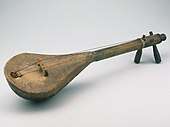 Morocco, pre-1981, skin-topped lute, carved wooden bowl, Amazigh, Amazighen, Berber cultures. Called "Lothar". Labeled "Gimbrī" in Koptishe Lauten (Ricardo Eichmann, 1994, page 101)
Morocco, pre-1981, skin-topped lute, carved wooden bowl, Amazigh, Amazighen, Berber cultures. Called "Lothar". Labeled "Gimbrī" in Koptishe Lauten (Ricardo Eichmann, 1994, page 101) West Africa, pre-1887, skin-topped lute, calabash bowl, has sound holes
West Africa, pre-1887, skin-topped lute, calabash bowl, has sound holes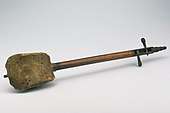 Egypt, pre-1930, skin-topped lute, river-turtle shell bowl, has sound holes, size and shape similar to Byzantine pandura
Egypt, pre-1930, skin-topped lute, river-turtle shell bowl, has sound holes, size and shape similar to Byzantine pandura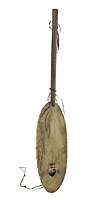 Mali, pre-1970, skin-topped lute, carved wooden bowl, Fellani, Foulah, Ful, Fulani, Fulbe, Peul, Toucouleur cultures, called "Hoddu"
Mali, pre-1970, skin-topped lute, carved wooden bowl, Fellani, Foulah, Ful, Fulani, Fulbe, Peul, Toucouleur cultures, called "Hoddu"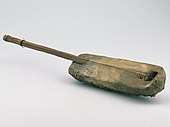 Africa, pre-1953, skin-topped lute, carved wooden bowl
Africa, pre-1953, skin-topped lute, carved wooden bowl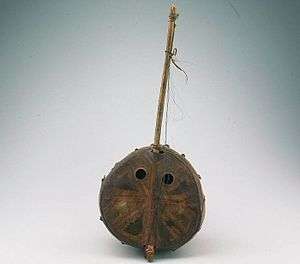 Libya, pre-1959, skin topped lute, calabash bowl, has sound holes, Touareg, Tuareg cultures
Libya, pre-1959, skin topped lute, calabash bowl, has sound holes, Touareg, Tuareg cultures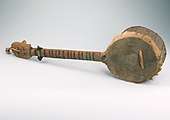 Rhodesia-Zambia, skin topped lute or banjo, metal can for body, Kaonde culture
Rhodesia-Zambia, skin topped lute or banjo, metal can for body, Kaonde culture
Gallery: long-necked lutes
.jpg) Alacahöyük 1399–1301 B.C., Hittite lute with in-curved sides, and frets on neck. Built like the Egyptian (skin top, stick woven through skin, sound holes parallel to stick-neck, one tassel to tie each string.). Unlike Egyptian lutes, stick pokes out at both ends).
Alacahöyük 1399–1301 B.C., Hittite lute with in-curved sides, and frets on neck. Built like the Egyptian (skin top, stick woven through skin, sound holes parallel to stick-neck, one tassel to tie each string.). Unlike Egyptian lutes, stick pokes out at both ends).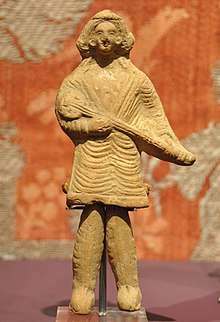 Parthian Empire, long-necked lute or tanbur, c. 3 B.C. – 3 A.D. Neck ends within body.
Parthian Empire, long-necked lute or tanbur, c. 3 B.C. – 3 A.D. Neck ends within body.
Greece and Rome, pandura
The long-necked lute traveled west as well as east. In the 5th century B.C. the Egyptian lute made it into Greek sculpture, recognizable as a pierced lute, stick running into an oval body, with triangular bridge at base of instrument and two lines of soundholes parallel to the stick, on either side of it.[31] A century later at Mantineia, the pierced lute would be changed, with a broader neck, somewhat shorter than the earlier Egyptian style lute, but still a long-necked instrument, with the neck longer than the soundbox.[32] A second version at Tanagra in 200 B.C. was carved from a single piece of wood, neck and soundbox, pear-shaped much as the short-lutes that later arrived from Central Asia.[33] Still another form of the pandura would have a one-piece carved triangular body with skin stretched across it.[34]
Sachs describes the pandura as having three strings, tied still to the neck as there were no pegs, and a small body.[10] The Greeks called the lute by multiple names, including trichordon (3-stringed) and pandura.[10] He looks as the latter name as evidence that the instrument was foreign to Greece, introduced from the East; the name was derived from pan-tur, a Sumerian name meaning small bow.[10] Sachs said that the instrument could be called "alternatively an Assyrian, a Cappadocian and an Egyptian instrument".[10]
While examples exist across 1100 years, the pandura was rarely covered in Greek and Roman art, compared to the cithara, harp and lyre. One possible reason had to do with cultural values. In the Mesopotamia and in Egypt, the lute had been associated with dancing girls and with entertainment. Sumerian pottery and clay statues show that the lute players were often naked performers, with sexuality a part of the performance. The Egyptian girls are similarly scantily clad, dancing for their lords and ladies.
A millennium later at Rome in the 5th century A.D., the pandura was a low-class instrument with a "disreputable association with frivolity and low merry-making".[35] A story about St Theodoulos the Stylite says that he was tested by God, forced to associate with Cornelius the pandouros (pandura player). According to the story, "Theodoulos is horrified at being associated with a man from the theatre" and more horrified to find "Cornelius at the Hippodrome, holding his instrument with one hand, and with the other, a bareheaded prostitute".[36]
Lack of artwork does not necessarily mean absence of the lute in Roman and Greek society. What images have survived of Greek and Roman pandura players are from high-class art. In the statuary, plaques and a mosaic in the Byzantine emperor's palace, players are dignified and clothed. The art, made for the wealthy upper classes doesn't show the lower-class places where Theodoulos was shocked.
Gallery: Egyptian, Coptic or Byzantine lutes
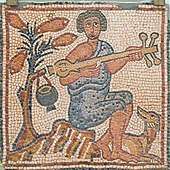 Coptic, Byzantine or Egyptian long-necked lute, 4th century A.D., Qasr Libya (the Byzantine city of Theodoureas)
Coptic, Byzantine or Egyptian long-necked lute, 4th century A.D., Qasr Libya (the Byzantine city of Theodoureas)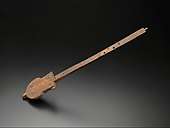 Coptic, Byzantine or Egyptian lute, c. 1–500 A.D.
Coptic, Byzantine or Egyptian lute, c. 1–500 A.D. Coptic, Byzantine or Egyptian lute, c. 1–500 A.D.
Coptic, Byzantine or Egyptian lute, c. 1–500 A.D. Coptic, Byzantine or Egyptian lute, c. 1–500 A.D., neck is hollow like rubab neck
Coptic, Byzantine or Egyptian lute, c. 1–500 A.D., neck is hollow like rubab neck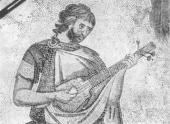 Byzantine pandura, 6th century A.D.
Byzantine pandura, 6th century A.D.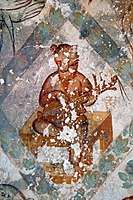 Unknown lute-family instrument, 623–643 A.D. Azraq. Byzantine/Islamic culture was mixing at time of painting.
Unknown lute-family instrument, 623–643 A.D. Azraq. Byzantine/Islamic culture was mixing at time of painting.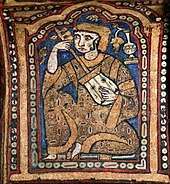 Unknown lute-family instrument, possible rubab or Coptic Lute. C 1140 A.D., Capella Palatina, Sicily.
Unknown lute-family instrument, possible rubab or Coptic Lute. C 1140 A.D., Capella Palatina, Sicily.
Tanbur family
Tanburs have been present in Mesopotamia since the Akkadian era, or the third millennium BC.[37]
Three figurines have been found in Susa that belong to 1500 BC, and in hands of one of them is a tanbur-like instrument.[38] Also an image on the rocks near Mosul that belong to about 1000 B.C. shows tanbur players.[38]
Playing the tanbur was common at least by the late Parthian era and Sassanid period,[39] and the word 'tanbur' is found in middle Persian and Parthian language texts, for instance in Drakht-i Asurig, Bundahishn, Kar-Namag i Ardashir i Pabagan, and Khosrow and Ridag.[note 1][38]
In the tenth century AD Al-Farabi described two types of tanburs found in Persia, a Baghdad tunbūr, distributed south and west of Baghdad, and a Khorasan tunbūr.[37][38] This distinction may be the source of modern differentiation between Arabic instruments, derived from the Baghdad tunbūr, and those found in northern Iraq, Syria, Iran, Sindh and Turkey, from the Khorasan tunbūr.[37]
The Persian name spread widely, eventually taking in long-necked string instruments used in Central Asian music such as the Dombura and the classical Turkish tambur as well as the Kurdish tembûr.[37][40] Until the early twentieth century, the names chambar and jumbush were applied to instruments in northern Iraq.[37] In India the name was applied to the tanpura (tambura), a fretless drone lute.[37] Tanbur traveled through Al-Hirah to the Arabian Peninsula and in the early Islam period went to the European countries. Tanbur was called 'tunbur' or 'tunbureh/tunbura' in Al-Hirah, and in Greek it was named tambouras, then went to albania as tampura, in Russia it was named domra, in Siberia and Mongolia as dombra, and in Byzantine Empire was named pandura/bandura. It travelled through Byzantine Empire to other European countries and was called pandura, mandura, bandura, etc.[38]
Later the Iranian (Kurdish) tanbur became associated with the music of the Ahl-e Haqq, a primarily Kurdish ghulat religious movement similar to a Sufi order, in Kurdish areas and in the Lorestān and Sistan va Baluchestan provinces of Iran, where it is called the 'tembûr'.[41]
Persians have another naming system for differentiating different styles of the instrument, using the word tar with a number for the number of strings or courses of strings.[42] Instruments named this way include the dutar (2 strings/courses), setar (three strings/courses), cartar (4 strings/courses) and panctar (five strings/courses).[42] A course is multiple strings played together, so that a setar can have 6 strings altogether, but the strings are divided in three rows or courses.
The pegs on the long-lutes are different than on short lutes (such as the oud) where a pegbox has pegs accessed from the sides.[42] On long lutes, some are inserted from the front, some from the side.[42] Sachs felt that the pegs were an indication of mixed origins for tanbur. Front and side elements came from Arabo/Persian instruments, rear pegs from Turkish.[42]
.
The tanbur family includes
- bağlama (Saz)
- bouzouki related to tanburs but also of European lute tradition
- çifteli
- cura
- dombra Dombura shares some of its characteristics with the Central Asian komuz and dutar.
- Dombura in Turkish ,
- Dombıra, in Uzbekistan and Tajikistan,
- Dambura or Danbura in northern Afghanistan, Tajikistan, and Uzbekistan,[1]
- Hazara Dambura or Hazaragi Dambura The Dambura which is played by Hazara people mostly in Afghanistan.[2]
- Dumbura in Bashkir and Tatar,
- Dombor in Mongolia,
- Dombyra in Kazakhstan,
- Dombira or 冬不拉 (Dongbula) in Xinjiang, China
- domra Russian instrument, recreated in the 1800s, modern version is shorter necked like mandolin
- balalaika Russian instrument. Related to domra.
- dutar
- komuz (not same as kobyz), Kyrgyz instrument. Placement of this instrument in tanbur family not certain. A skin-topped version has existed.
- pandura
- sato (bowed)
- setar looks very similar to tanbur. Has three courses of strings (normally four strings total, but as many as six)
- setor
- sitar
- tambura, played in Balkan peninsula, possibly identical to tamburica
- tamboori an Indian melodic instrument similar to a Tanpura
- tambouras played in Greece
- tamburica any member of a family of long-necked lutes popular in Eastern and Central Europe
- tanbur, tanbur, tanbūr, Tambur a long-necked, string instrument originating in the Southern or Central Asia (Mesopotamia and Persia/Iran). Three strings total (not courses).
- Iranian tanbur (Kurdish tanbur), used in Yarsan rituals
- Turkish tambur, instrument played in Turkey
- Yaylı tambur, also played in Turkey
- tanpura, a drone instrument played in India
- tar
- tembor
- tzouras
Instruments not included on this list provide a chance to think about the instruments' evolution. Early Mesopotamian long-necked lutes would have had skin tops and sound-bowls that were either carved from wood or made from a turtle shell. There was a divergence; modern tanburs have wood tops, while rubabs have skin tops. One instrument straddled the line, the Byzantine or Coptic lute. These appear to have been successors of the middle east long-lute tradition, in which Egypt participated. They have a wooden soundboard (a tanbur trait), however, the neck is hollow (a rubab trait). Also the Byzantine lute from Qasr Libya, in Libya, has barbs on its top, a rubab trait. The Coptic lute also overlaps with an instrument that Curt Sachs called a pandura, the instrument illustrated in the mosaic in the Byzantine emperor's palace in Constantinople.
The other long lutes not included here are because of their rubab orientation are the dotara, dramyin, rawap and pamiri rubab. They have soundboards of skin and may also have hollow necks.
Gallery: Tanbur family lutes
 bağlama or Azerbaijani saz (left)
bağlama or Azerbaijani saz (left)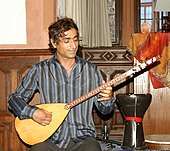 bağlama or saz
bağlama or saz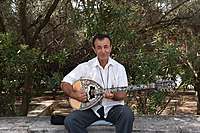 Greek bouzouki
Greek bouzouki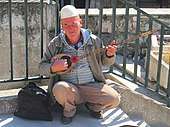
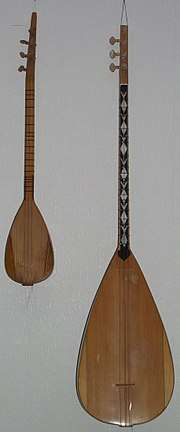
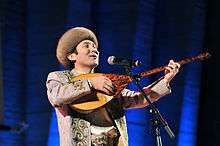 Dombra or dambura
Dombra or dambura Uzbek dutar. Also Tajik
Uzbek dutar. Also Tajik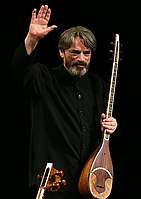 Iranian setar, musician Hossein Alizadeh
Iranian setar, musician Hossein Alizadeh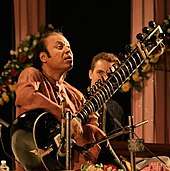 Indian sitar
Indian sitar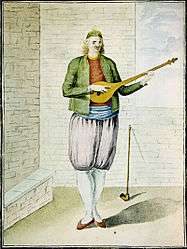 Greek tambouras
Greek tambouras Southern/Central European tamburica
Southern/Central European tamburica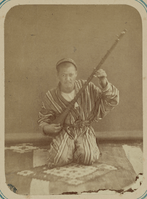 Central Asian tanbur/tambur, 1865–1872
Central Asian tanbur/tambur, 1865–1872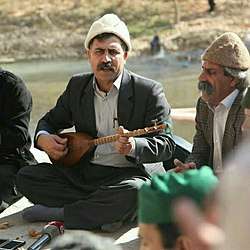 Iranian/Kurdish tanbur
Iranian/Kurdish tanbur Ottoman tambur, also known as Turkish tambur, 1880
Ottoman tambur, also known as Turkish tambur, 1880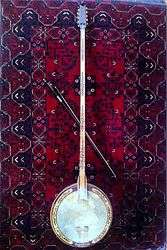 Yayli tambur a variation of Turkish tambur, metal and uses a bow
Yayli tambur a variation of Turkish tambur, metal and uses a bow.jpg)
Chinese sanxian
It has been suggested that the sanxian, a form of spike lute, may have its origin in the Middle East, and older forms of spike lute were also found in ancient Egypt.[43] Similar instruments may have been present in China as early as the Qin dynasty as qin pipa (pipa was used as a generic term in ancient China for many other forms of plucked chordophones) or xiantao (弦鼗).[43][44] Some thought that the instrument may have been re-introduced into China together with other instruments such as huqin by the Mongols during the Yuan dynasty (1271–1368),[43][45] however, an image of a sanxian-like instrument was found in a stone sculpture dating from the Southern Song period (1217–79). The first record of the name "sanxian" may be found in a Ming dynasty text.[46][45]
The instrument was transmitted to other East Asian countries, for example to Japan as shamisen.[47][48]
Short-necked lutes
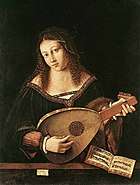
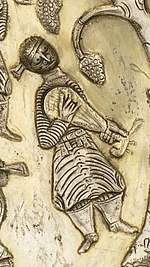
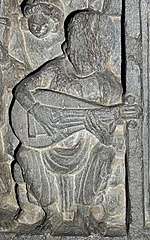
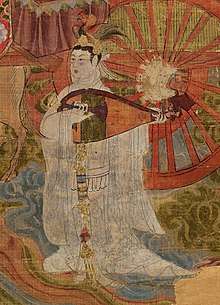
Although the oldest iconographic evidence concerning lutes deals with long lutes in Mesopotamia and Egypt, some long-necked lutes are shorter than others. Comparatively, the Greek and Byzantine pandura is shorter than the tanbur, even though both are long lutes. Shorter lutes exist among the long-necked lutes today, including the tanburica, cura and komuz.
A short necked lute does not necessarily a small lute, as a pipa can be a large instrument. Guitars have a sound box as long as the neck. Some members of the rubab family with their long sounds-boxes fit into the group of short-necked lutes.
The line of short-necked lutes developed to the east of Mesopotamia, in Central Asia, places like Bactria and Gandhara. There a short, almond-shaped lute surfaced, carried east and West by Sogdiana merchants, become the Chinese pipa and Middle Eastern oud.[50][51][52] Curt Sachs talked about the depictions of Ganharan lutes in art, where they are presented in a mix of "Northwest Indian art" under "a strong Greek influence".[53] The short-necked lutes in these Gandhara artworks were "the venerable ancestor of the Islamic, the Sino-Japanese and the European lute families".[53] He described the Ganhara lutes as having a "pear-shaped body tapering towards the short neck, a frontal stringholder, lateral pegs, and either four or five strings".[53] While the earliest may be in the Gandhara region, Northern India itself also has ancient short-necked lutes in sculpture, such as one found at Pawāyā, Madhya Pradesh, India, that dates to the Gupta period, 400–499 A.D.[54][55]
Much of short lute development happened in the Central Asian area between India, China and Persia. Early short were carved out of a single block of wood, not built up in a box or bowl-like modern lutes. An example is the barbat which has been called ancestral to both skin-topped instruments like the gambus as well as to larger wood-topped instruments such as the oud. Names were reused or used across multiple instruments over the millennia; the rabab group is an example of that. The family included short lute-shaped instruments, to larger lutes with multiple chambers (some covered with wood, some with skin), to long-necked lutes that retained the multiple sound chambers and skin over the bowl. Some rababs were plucked, some bowed.
Central Asia, the crossroads of civilizations
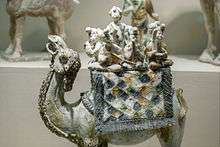

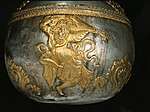
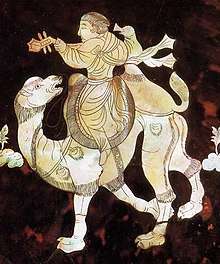
It has been argued that Central Asia, a crossroads of multiple civilizations, the Middle East, Europe, China and India, could itself constitute a center of world civilization.[58] It was described by the Greek geographer, Strabo, as "a land of 1000 cities."[59] The peoples there could be loosely called Iranians, the historic tribes, not only citizens of the modern country. Over a period of centuries Central Asia was conquered by people from different cultures including the Greeks, Kushans, various Turkic tribes, Persians (themselves an Iranian tribe), and Arabs. The result was a blending of the cultures, and Central Asian grew prosperous in spite of the invasions.
When the Arabs conquered Central Asia, they were conquering a culture that specialized in taking things, evaluating them for their potential value and improving on them. Their habit of evaluating applied to products to sell and to ideas.[60][61] Central Asia was pluralistic and diverse and had some of the biggest cities on the planet, with books being "numerous and widespread", and a high rate of literacy, in which even women could read and write.[62] The culture of literacy and evaluation continued after the Arabs burned the Central Asian libraries (an attempt to do away with competing ideas). Arabic became a lingua-franca, joining Central Asia with the wider Muslim academic world. When the Greek classics were translated into Arabic, Central Asian polymaths worked with the translated Greek science and philosophy, making scientific discoveries that wouldn't be duplicated until the European Renaissance.
Among the products manufactured and exported to China were "lutes, harps, transverse flutes, both plucked and bowed stringed instruments, and even Central Asian dances."[63][64] One of the peoples, the Sogdians were successful merchants for centuries and traveled to Europe, China and India.[65] They took their music and dances with them, and the Sogdian Whirl, became popular in China. Another group from Central Asia was the people of Kucha, whose music and dances were popular in the Imperial Court, and which have survived in the Japanese Imperial Court into the modern era.[57]
Pipa, ruan and yueqin

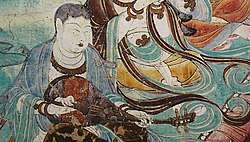

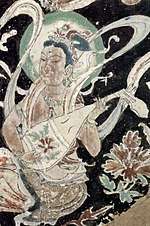
Pipa
The pear-shaped pipa is likely to have been introduced to China from Central Asia, Gandhara, and/or India.[67] Pear-shaped lutes have been depicted in Kusana sculptures from the 1st century AD.[68][69]
The pear-shaped pipa may have been introduced during the Han Dynasty and was referred to as Han pipa. However, depictions of the pear-shaped pipas in China only appeared after the Han Dynasty during the Jin Dynasty in the late 4th to early 5th century.[70]
A small pipa was found in murals of tombs in Liaoning (遼寧) province in northeastern China. The date of these tombs is about late Eastern Han (東漢) or Wei (魏) period (220–265 AD). However, the pear-shaped pipa was not brought to China from Dunhuang (敦煌, now in northwestern China) until the Northern Wei period (386–524 AD) when ancient China traded with the western countries through the Silk Road (絲綢之路). Evidence was shown on the Dunhuang Caves frescoes that the frescoes contain a large number of pipa, and they date to 4th to 5th century.[71]
Pipa acquired a number of Chinese symbolisms during the Han Dynasty - the instrument length of three feet five inches represents the three realms (heaven, earth, and man) and the five elements, while the four strings represent the four seasons.[72]
Depictions of the pear-shaped pipas appeared in abundance from the Southern and Northern Dynasties (420 to 589) onwards, and pipas from this time to the Tang Dynasty were given various names, such as Hu pipa (胡琵琶), bent-neck pipa (曲項琵琶, quxiang pipa), some of these terms, however, may refer to the same pipa. Apart from the four-stringed pipa, other pear-shaped instruments introduced include the five-stringed, straight-necked, wuxian pipa (五弦琵琶, also known as Kuchean pipa (龜茲琵琶)),[73] a six-stringed version, as well as the two-stringed hulei (忽雷). From the 3rd century onwards, through the Sui and Tang Dynasty, the pear-shaped pipas became increasingly popular in China. By the Song Dynasty the word pipa was used to refer exclusively to the four-stringed pear-shaped instrument.
Ruan and yueqin

Another type of lute in China is the yueqin, a round-bodied instrument with flat top and back. According to tradition, the instrument was invented in China during the 3rd to 5th century A.D. Jin Dynasty.[75] The ruan, another Chinese instrument, is the ancestor of the yueqin.[75] The period overlaps with the period of immigration of ancient non-Han Chinese peoples and invasions, by groups such as the Five Barbarians.
The yueqin is a type of ruan, what may be China's oldest lute. Ruans may have a history of over 2,000 years, the earliest form may be the qin pipa (秦琵琶), which was then developed into ruanxian (named after Ruan Xian, 阮咸), shortened to ruan (阮).[1][2] In old Chinese texts from the Han to the Tang dynasty, the term pipa was used as a generic term for a number plucked chordophones, including ruan, therefore does not necessarily mean the same as the modern usage of pipa which refers only to the pear-shaped instrument. According to the Pipa Annals 《琵琶赋》 by Fu Xuan (傅玄) of the Western Jin Dynasty, the pipa was designed after revision of other Chinese plucked string instruments of the day such as the Chinese zither, zheng (筝) and zhu (筑), or konghou (箜篌), the Chinese harp.[3] However, it is believed that ruan may have been descended from an instrument called xiantao (弦鼗) which was constructed by labourers on the Great Wall of China during the late Qin Dynasty (hence the name Qin pipa) using strings stretched over a pellet drum.[4]
The antecedent of ruan in the Qin Dynasty (221 BC – 206 BC), i.e. the Qin pipa, had a long, straight neck with a round sound box in contrast to the pear-shape of pipa of later dynasties. The name of "pipa" is associated with "tantiao" (彈挑), a right hand techniques of playing a plucked string instrument. "Pi" (琵), which means "tan" (彈), is the downward movement of plucking the string. "Pa" (琶), which means "tiao" (挑), is the upward movement of plucking the string.[5]
The present name of the Qin pipa, which is "ruan", was not given until the Tang Dynasty (8th century). During the reign of Empress Wu Zetian (武則天) (about 684–704 AD), a copper instrument that looked like the Qin pipa was discovered in an ancient tomb in Sichuan (四川).[76] It had 13 frets and a round sound box. It was believed that it was the instrument which the Eastern Jin (東晉) musician Ruan Xian (阮咸) loved to play.[77]
Nowadays, although the ruan was never as popular as the pipa, the ruan has been divided into several smaller and better-known instruments within the recent few centuries, such as yueqin ("moon" lute, 月琴) and qinqin (Qin [Dynasty] lute, 秦琴) . The short-necked yueqin, with no sound holes, is now used primarily in Beijing opera accompaniment. The long-necked qinqin is a member of both Cantonese (廣東) and Chaozhou (潮州) ensembles.[78]
Gallery: Asian plucked lutes, long and short-necked
Musical instruments came into China from Central Asia, such as the pipa, or may have been invented locally such as the Qin-Pipa or sanxian. China became a source of instruments for (or shares instruments in common with) other cultures, including Korea, Japan and Vietnam. Three ways to categorized these are:
- short-necked pipas (such as the pipa, liuqin, bipa, and Tỳ bà)
- short and long-necked moon lutes (such as the yueqin, ruan, gekkin, đàn tứ, đàn đáy, zhongruan, qinqin, đàn sến, đàn nguyệt)
- long-necked lutes ( such as the sanxian, shamisen, đàn tam, and đàn tính).
_(2).jpg) China, pipa, 2008.
China, pipa, 2008..jpg) Japan, biwa
Japan, biwa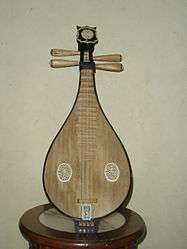 China, liuqin, smaller than pipa
China, liuqin, smaller than pipa.jpg) Korea, bipa
Korea, bipa Vietnam, đàn tỳ bà
Vietnam, đàn tỳ bà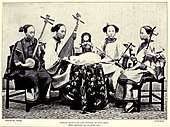
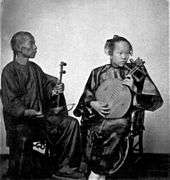
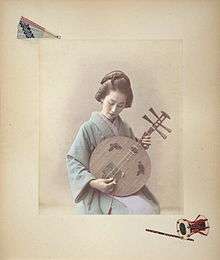 Japan, gekkin, 1886.
Japan, gekkin, 1886.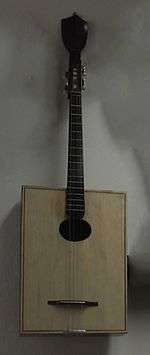
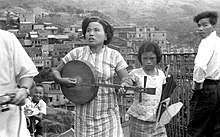
.jpg) Vietnam, đàn nguyệt literally means "moon string-instrument" (đàn is the generic term for "string instrument" and nguyệt means "moon"). Image taken in Australia, 2017
Vietnam, đàn nguyệt literally means "moon string-instrument" (đàn is the generic term for "string instrument" and nguyệt means "moon"). Image taken in Australia, 2017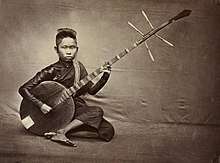 Cambodia, Chapei dong veng (ចាប៉ីដងវែង) and Thailand grajabpi (กระจับปี่), c. 1880. Origin uncertain: China (ruan or yueqin), Islamic (rubab or tanbir), India ("chapei derives from the Sanskrit kacchap(î)" turtle shell, used for sound bowl).[79]
Cambodia, Chapei dong veng (ចាប៉ីដងវែង) and Thailand grajabpi (กระจับปี่), c. 1880. Origin uncertain: China (ruan or yueqin), Islamic (rubab or tanbir), India ("chapei derives from the Sanskrit kacchap(î)" turtle shell, used for sound bowl).[79]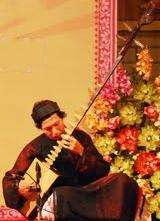
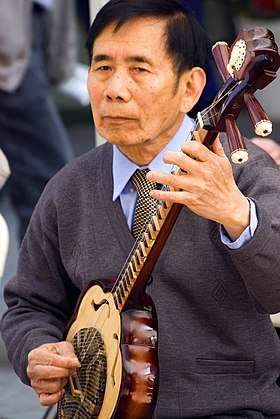 China, qinqin (秦琴) or plum blossom qin (梅花琴)
China, qinqin (秦琴) or plum blossom qin (梅花琴)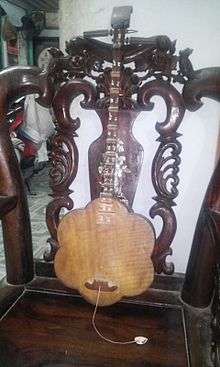 Vietnam, đàn sến. Vietnamese version of qingin
Vietnam, đàn sến. Vietnamese version of qingin_(4).jpg) Vietnam đàn nguyệt or đàn sến
Vietnam đàn nguyệt or đàn sến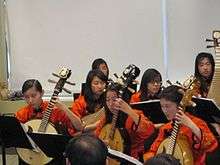 Larger ruans in an orchestra
Larger ruans in an orchestra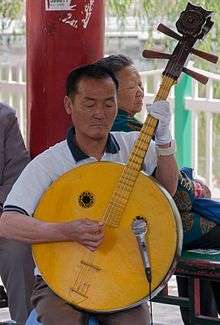 China, ruan-family instrument, either a bass daruan (大阮) or contrabass diyinruan (低音阮)
China, ruan-family instrument, either a bass daruan (大阮) or contrabass diyinruan (低音阮)- China, sanxian, 1780.
 Vietnam, đàn tính, or tính tẩu. Gourd lute. A musical instrument of some ethnic groups in Northern mountainous region in Vietnam
Vietnam, đàn tính, or tính tẩu. Gourd lute. A musical instrument of some ethnic groups in Northern mountainous region in Vietnam Thailand sueng
Thailand sueng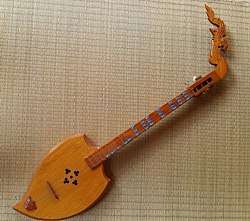 Thailand and Laos, phin
Thailand and Laos, phin
Entering the Middle East, Northern Africa and Europe, the barbat and oud
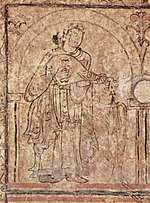
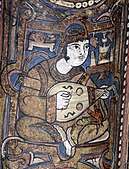

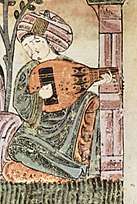
Bactria and Gandhara became part of the Sasanian Empire (224–651), the last empire of the Persians. Under the Sasanians, a short almond shaped lute from Bactria came to be called the barbat or barbud, which was developed into the later Islamic world's oud or ud.[80] The lute was brought from Al-Hira in Persia to Mecca by Nadr ibn al-Harith, probably prior to 602 A.D. and was adopted by the Quraish, a mercantile Arab tribe.[81] He taught the instrument and the song (ghina) that accompanied it to his people, where the instrument and song "were adopted by singing girls".[81] Early Arab musicians to use the lute include Sā'ib Khāthir (died 683 A.D.), who brought the lute to Medina and Ibn Suraij in Mecca, said to have been the first to sing Arab songs on a lute "built in the Persian style" in 684 A.D.[81][82]
When the Moors conquered Andalusia in 711, they brought their ud or quitra along, into a country that had already known a lute tradition under the Romans, the pandura.
During the 8th and 9th centuries, many musicians and artists from across the Islamic world flocked to Iberia.[83] Among them was Abu l-Hasan ‘Ali Ibn Nafi‘ (789–857),[84][85] a prominent musician who had trained under Ishaq al-Mawsili (d. 850) in Baghdad and was exiled to Andalusia before 833 AD. He taught and has been credited with adding a fifth string to his oud[80] and with establishing one of the first schools of music in Córdoba.[86]
By the 11th century, Muslim sections of Spain, or Al-Andalus, had become a center for the manufacture of instruments. These goods spread gradually to Provence, influencing French troubadours and trouvères and eventually reaching the rest of Europe. While Europe developed the lute, the oud remained a central part of Arab music, and broader Ottoman music as well, undergoing a range of transformations.[87]
Beside the introduction of the lute to Spain by the Moors, another important point of transfer of the lute from Arabian to European culture was Sicily, where it was brought either by Byzantine or later by Muslim musicians.[88] There were singer-lutenists at the court in Palermo following the Norman conquest of the island from the Muslims, and the lute is depicted extensively in the ceiling paintings in the Palermo’s royal Cappella Palatina, dedicated by the Norman King Roger II of Sicily in 1140.[88] His Hohenstaufen grandson Frederick II, Holy Roman Emperor (1194–1250) continued integrating Muslims into his court, including Moorish musicians.[89] By the fourteenth century, lutes had disseminated throughout Italy and, probably because of the cultural influence of the Hohenstaufen kings and emperor, based in Palermo, the lute had also made significant inroads into the German-speaking lands.
Although the major entry of the short lute was in western Europe, leading to a variety of lute styles, the short lute entered Europe in the East as well; as early as the sixth century, the Bulgars brought the short-necked variety of the instrument called Komuz to the Balkans.
Additionally, the Byzantine Empire bordered on both Europe and Persia. The Central Asian lute, now middle Eastern, can be seen in Byzantine artwork from the 9th or 10th century.[90]
Muslim and European instruments, blended tradition
Fusion, instruments and music
Instruments from approximately the 12th and 13th centuries in Spain and Sicily, areas conquered by Muslims and then European Christians. Instrument identities are educated guesses, even by experts, as none of these were labeled and historical descriptions of different types are vague. Places where cultures interact is a breeding ground of new ideas, where experimentation creates new instruments, the same process that blends different types of music to create new music by fusion. A similar process happened in Central Asia, over centuries of repeated trade by different cultures and conquests by different tribes.
Even after the Muslims were conquered in Spain or driven out, the process of experimentation continued, leading to a number of European instruments, including the guitar. A similar process occurred in Italy. Both Spain and Italy experimented with the viol or vihuela which led to bowed viols, violas vielles, and guitars. Other experiments led to the citole and cittern or Portuguese guitar, the gittern and vandola (mandore, mandola) which also led to the guitar, but also to the mandolin family. Spanish instruments that survived in Spanish colonies include the tiple.
Portuguese experiments led to the Portuguese guitar, and other instruments seen today in places that Portuguese ships landed, including the cavaquinho and ukulele.
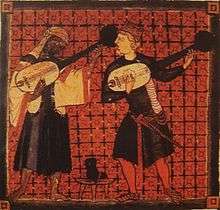 Al Andalus, Cantigas de Santa Maria, Musicians playing lute-family instruments. These have been called guitarra latina, guitarra morisca and tambura
Al Andalus, Cantigas de Santa Maria, Musicians playing lute-family instruments. These have been called guitarra latina, guitarra morisca and tambura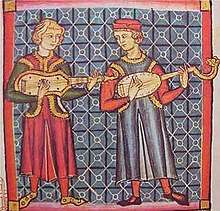 Al Andalus, Cantigas de Santa Maria, European musicians playing lute family instruments, possibly (left) citoles or guitarra latina and (right) guitarra morisca
Al Andalus, Cantigas de Santa Maria, European musicians playing lute family instruments, possibly (left) citoles or guitarra latina and (right) guitarra morisca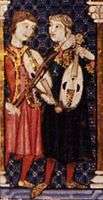 Al Andalus, Cantigas de Santa Maria, European musicians playing viola de arco
Al Andalus, Cantigas de Santa Maria, European musicians playing viola de arco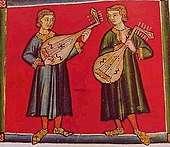 Al Andalus, Cantigas de Santa Maria, Europeans holding lutes with W sound holes (a Muslim instrument feature) and the drilled dots (found on the Gambus and on Eastern European lutes into the early 20th century A.D.
Al Andalus, Cantigas de Santa Maria, Europeans holding lutes with W sound holes (a Muslim instrument feature) and the drilled dots (found on the Gambus and on Eastern European lutes into the early 20th century A.D.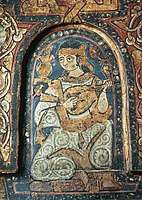 Palmero, Sicily, c. 1140 A.D., oud from the Capella Palatina.
Palmero, Sicily, c. 1140 A.D., oud from the Capella Palatina. Al Andalus, Cantigas de Santa Maria, European musicians playing (left) viola de arco and (right) citoles or plucked fiddles or guitarra latina
Al Andalus, Cantigas de Santa Maria, European musicians playing (left) viola de arco and (right) citoles or plucked fiddles or guitarra latina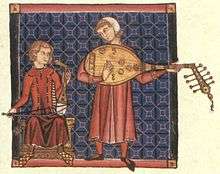
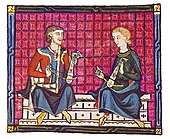 Al Andalus, Cantigas de Santa Maria, Andalusian or Magreb rebab
Al Andalus, Cantigas de Santa Maria, Andalusian or Magreb rebab.jpg) Al Andalus, Cantigas de Santa Maria, Right Image:Vielle or viola de arco and citole or guitarra latina. Left image Vielle
Al Andalus, Cantigas de Santa Maria, Right Image:Vielle or viola de arco and citole or guitarra latina. Left image Vielle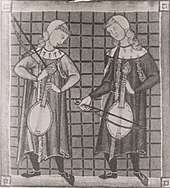 Al Andalus, Cantigas de Santa Maria, unknown fiddles
Al Andalus, Cantigas de Santa Maria, unknown fiddles Al Andalus, Cantigas de Santa Maria, fiddle and plucked fiddle.
Al Andalus, Cantigas de Santa Maria, fiddle and plucked fiddle.%2C_fol._5r%2C_detail.jpg) two vielles and a citole
two vielles and a citole- Sicily, c. 1140 A.D. Lute family instrument or rubab. Not clear whether wood or leather top; both rubab and lute style soundholes.
.jpg) Sicily, 12th Century image from the Cefalù Cathedral. Skin topped lute, possibly guitarra morisca or rubab
Sicily, 12th Century image from the Cefalù Cathedral. Skin topped lute, possibly guitarra morisca or rubab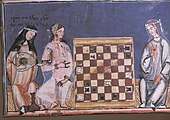 León and Galicia, c. 1283. European image of Muslim Spain, showing a European woman, playing lute or oud for Moorish women.
León and Galicia, c. 1283. European image of Muslim Spain, showing a European woman, playing lute or oud for Moorish women.
Gambus and rabâb, skin tops plucked and bowed, rebab, rubab rabâb, robab
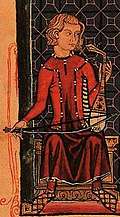
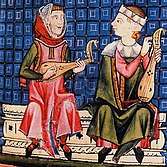
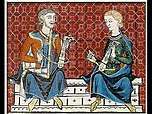
In The History of Musical Instruments, Sachs talked about a second kind of short lute found in the "Islamic Near East", carved from a single piece of wood, no distinct neck and a pegbox that was sickle shaped.[91] There was also a kind with "an inferior stringholder".[91]
The instruments that would become the gambus with sickle shaped pegbox traveled east "as far as the Celebes in Southeast Asia and southwards to Madagascar off the east coast of Africa".[91] Another scholar thinks they traveled across the Indian ocean as well on Yemeni ships, as the Yemeni quanbus The gambus is among the last of the family of skin-topped lutes. Sachs names the instruments gambus, kabosa and qūpūz.[91]
The gambus is plucked, but many of the variants are bowed. By the time the instrument became bowed, it was named rabâb, a name that has been used for long-necked skin topped instruments as well.[91] The Cantigas de Santa Maria in Southern Spain had examples of both bowed and unbowed instruments.
The early instruments traveled west to enter Europe through Andalusia and Eastern Europe where they gained wooden tops and became lyras. In Yemen, the instrument was known as the quanbus. It traveled to Southeast Asia with Yemeni sailors. Over time, some of these became intertwine with spike fiddles. Variations of these instruments can be found in China, Southeast Asia, Central Asia, and Europe.
Variations include the rebabs that spread via Islamic trading routes over much of North Africa, the Middle East, parts of Europe, and the Far East.[93] The Medieval European Rebec, Croatian Lijerica, Cretan Cretan lyra, Bulgarian Gadulka and Russian Gudok, the Gusle used in Serbia, Romania, Albania and Bulgaria, the Eastern Mediterranean Kemenche and Persian Kamancheh, the Kazakh Kobyz, Bangladeshi Ektara are variations.
Gallery
Gallery: skin topped lutes and rubabs
These can blur the line between long-necked instruments and short necked. The soundbox is, in some cases, so long that it effectively adds to the instrument's scale-length, like a long neck.
- gambus or qanbūs
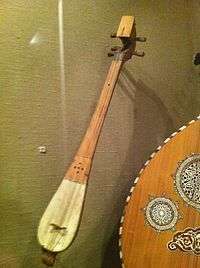 qanbūs, 1899, Syria
qanbūs, 1899, Syria- Pakistani Rubab with upper sound chamber exposed
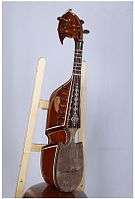 short Iranian robab, upper sound chamber covered with wood, top has frets
short Iranian robab, upper sound chamber covered with wood, top has frets- Afghani rubab, top has frets
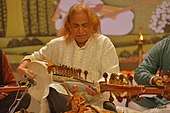 Indian sarod, descended from Afghani rubab, has no frets
Indian sarod, descended from Afghani rubab, has no frets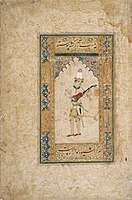 Iran, rubab or tar, (possibly showing wooden upper top, skin lower top), c. Late 16th century A.D.
Iran, rubab or tar, (possibly showing wooden upper top, skin lower top), c. Late 16th century A.D.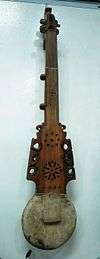 Pamiri rubab, longer necked type of rubab, sound holes up neck show it is hollow
Pamiri rubab, longer necked type of rubab, sound holes up neck show it is hollow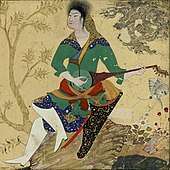 Iranian style rubab c. 1590, longer neck, painted by Muhammad Jaffar
Iranian style rubab c. 1590, longer neck, painted by Muhammad Jaffar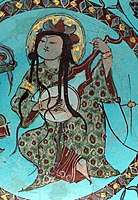 Iranian or Persian rubab, late-12th to early 13th century A.D., Iran
Iranian or Persian rubab, late-12th to early 13th century A.D., Iran Dramyin or dranyen, 2005, Tibet
Dramyin or dranyen, 2005, Tibet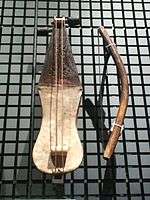 Rabab Andalusiyyah (Andalusian Rabab), 1991, Morocco
Rabab Andalusiyyah (Andalusian Rabab), 1991, Morocco- Iranian tar, being double sound chambered with a skin top, has features of a rubab
Gallery: spike fiddles, bowed rabâbs, kamanchas, liras
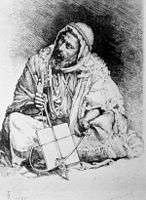 rabâb saharaoui, 1879
rabâb saharaoui, 1879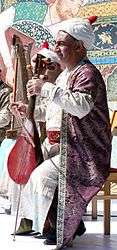 Chagane, 2010, Azerbaijan
Chagane, 2010, Azerbaijan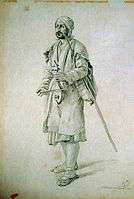 kemenche, 1844
kemenche, 1844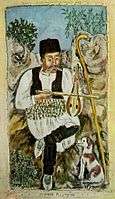 kemenche, Greece, late 19th or early 20th century
kemenche, Greece, late 19th or early 20th century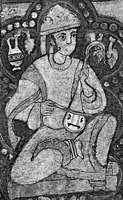 Rebab, Sicily, c 1140 A.D. Painting from the Cappella Palatina. Same sound holes found on Al Andalusia lutes
Rebab, Sicily, c 1140 A.D. Painting from the Cappella Palatina. Same sound holes found on Al Andalusia lutes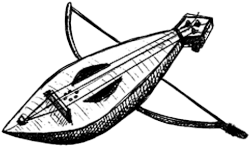 gudok, Russia
gudok, Russia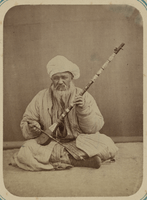 kamancha, a Long-necked Stringed Instrument, c. 1865-1872, Turkestan
kamancha, a Long-necked Stringed Instrument, c. 1865-1872, Turkestan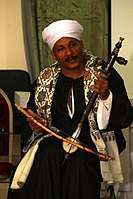 kamancheh, 2016, Egypt
kamancheh, 2016, Egypt.jpg) kamancheh, 1669, Iran
kamancheh, 1669, Iran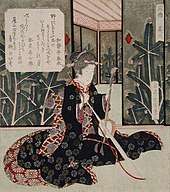 kokyū, Japan, 19th century
kokyū, Japan, 19th century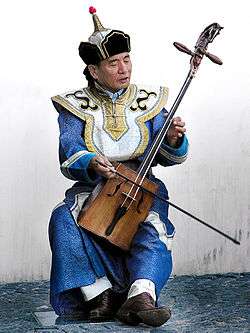 morin khuur, Mongolia 2005
morin khuur, Mongolia 2005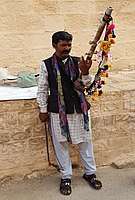 ravanahatha, 2017, India
ravanahatha, 2017, India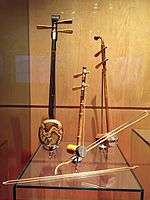 huqin-family instruments, China
huqin-family instruments, China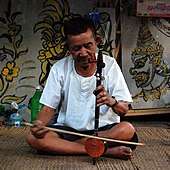
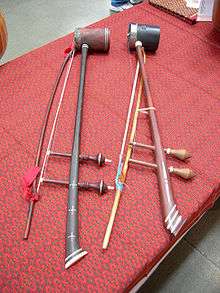 Cambodia, Tro (ទ្រ). This family of instruments includes coconut-shell tro u (ទ្រអ៊ូ), small hardwood tro sau toch (ទ្រសោតូច), bigger hardwood tro sau thom (ទ្រសោធំ), and the tro che. Also a three-stringed tro Khmer (ទ្រខ្មែរ).
Cambodia, Tro (ទ្រ). This family of instruments includes coconut-shell tro u (ទ្រអ៊ូ), small hardwood tro sau toch (ទ្រសោតូច), bigger hardwood tro sau thom (ទ្រសោធំ), and the tro che. Also a three-stringed tro Khmer (ទ្រខ្មែរ). Cambodia, c. 1880, tro Khmer (ទ្រខ្មែរ)
Cambodia, c. 1880, tro Khmer (ទ្រខ្មែរ)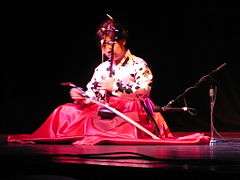 Korea, haegeum 2 strings
Korea, haegeum 2 strings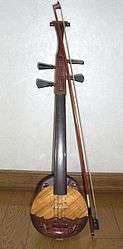 North Korea, sohaegeum, 4 strings
North Korea, sohaegeum, 4 strings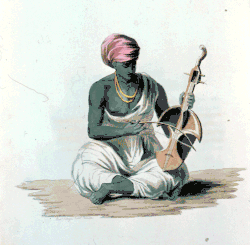 India, sarinda
India, sarinda
European lutes
Lute



The European lute and the modern Near-Eastern oud descend from a common ancestor via diverging evolutionary paths. The lute is used in a great variety of instrumental music from the Medieval to the late Baroque eras and was the most important instrument for secular music in the Renaissance.[94] During the Baroque music era, the lute was used as one of the instruments which played the basso continuo accompaniment parts. It is also an accompanying instrument in vocal works. The lute player either improvises ("realizes") a chordal accompaniment based on the figured bass part, or plays a written-out accompaniment (both music notation and tabulature ("tab") are used for lute). As a small instrument, the lute produces a relatively quiet sound.
Medieval lutes were 4- or 5-course instruments, plucked using a quill as a plectrum. There were several sizes, and by the end of the Renaissance, seven different sizes (up to the great octave bass) are documented. Song accompaniment was probably the lute's primary function in the Middle Ages, but very little music securely attributable to the lute survives from the era before 1500. Medieval and early-Renaissance song accompaniments were probably mostly improvised, hence the lack of written records.
In the last few decades of the fifteenth century, to play Renaissance polyphony on a single instrument, lutenists gradually abandoned the quill in favor of plucking the instrument with the fingertips. The number of courses grew to six and beyond. The lute was the premier solo instrument of the sixteenth century, but continued to accompany singers as well.
In about the year 1500 many Iberian lutenists adopted vihuela de mano, a viol-shaped instrument tuned like the lute, but both instruments continued in coexistence. This instrument also found its way to parts of Italy that were under Spanish domination (especially Sicily and the papal states under the Borgia pope Alexander VI who brought many Catalan musicians to Italy), where it was known as the viola da mano.
By the end of the Renaissance the number of courses had grown to ten, and during the Baroque era the number continued to grow until it reached 14 (and occasionally as many as 19). These instruments, with up to 26–35 strings, required innovations in the structure of the lute. At the end of the lute's evolution the archlute, theorbo and torban had long extensions attached to the main tuning head to provide a greater resonating length for the bass strings, and since human fingers are not long enough to stop strings across a neck wide enough to hold 14 courses, the bass strings were placed outside the fretboard, and were played open, i.e., without pressing them against the fingerboard with the left hand.
Over the course of the Baroque era the lute was increasingly relegated to the continuo accompaniment, and was eventually superseded in that role by keyboard instruments. The lute almost fell out of use after 1800. Some sorts of lute were still used for some time in Germany, Sweden, Ukraine.
Bowed fiddles, lyra, kamānģa rūmī, vièla, viola
Spain had bowed instruments as early as the 10th and 11th centuries A.D., when they were included in Spanish manuscripts, such as the Commentary on the Apocalypse Beatus of Liébana Emilianense Codex.[95][96]
The Byzantines had a bowed lute called a "kamānģa rūmī" in the east, also known as the Byzantine lira in "Greece, Bulgaria and Yugoslavia".[95] The instrument still has a presence in the Eastern Mediterranean, in Southern Italy as the Calabrian lira, in Bulgaria as the gadulka, in Greece, Iran, Turkey, Armenia, and regions adjacent to the Black Sea the kemenche, in Dalmatia as the lijerica.
Sachs said that the Byzantine lyra would become the main bowed instrument in Europe, eventually becoming the "fiddle, vièle, [and] viola".[95] The rebec also had a presence in Europe, but was not derived from the lyra but from the rabâb.[95]
Cythara, a European lute-building tradition?
The word cythara was used generically for a wide variety stringed instruments of medieval and Renaissance Europe, including not only the lyre and harp but also necked, string instruments.[97] In fact, unless a medieval document gives an indication that it meant a necked instrument, then it likely was referring to a lyre. It was also spelled cithara or kithara and was Latin for the Greek lyre.[97] However, lacking names for some stringed instruments from the medieval period, these have been referred to as fiddles and citharas/cytharas, both by medieval people and by modern researchers. The instruments are important as being ancestors to or influential in the development of a wide variety of European instruments, including fiddles, vielles, violas, citoles, guitars. Although not proven to be completely separate from the line of lute-family instruments that dominated Europe (lute, oud, gittern, mandore), arguments have been made that they represent a European-based tradition of instrument building, which was for a time separate from the lute-family instruments.
Gallery: Europe, lutes of unknown development lines
Images that have been labeled "cythara" in the medieval documents that they came from. Their lineage is not clearly understood. The Rylands Beatus instruments come from Spain, and may link to the Arabian/Muslim traditions of instrument making there, or be a form of plucked-fiddle, similar to those seen in Central Asia (an area that the Persians and Arabs conquered and picked up musical traditions from.)
The traditions of other cytharas are less understood and may represent a time of European experimentation, in which the cithara-lyre was transformed into the cythara-lute.
 Stuttgart Psalter, 820–830 A.D., cythara
Stuttgart Psalter, 820–830 A.D., cythara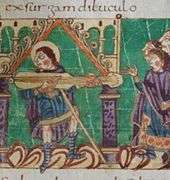 Stuttgart Psalter, 820–830 A.D., cythara
Stuttgart Psalter, 820–830 A.D., cythara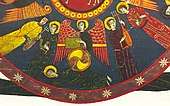 Beatus of Liébana, Ms. Vitr. 14.2, 1047 A.D., angels holding cytharas
Beatus of Liébana, Ms. Vitr. 14.2, 1047 A.D., angels holding cytharas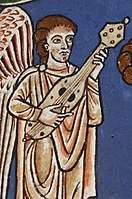 Rylands Beatus, c. 1175, cythara
Rylands Beatus, c. 1175, cythara Rylands Beatus, c. 1175, cythara
Rylands Beatus, c. 1175, cythara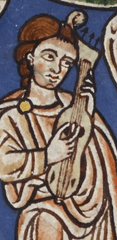 Rylands Beatus, c. 1175, cythara
Rylands Beatus, c. 1175, cythara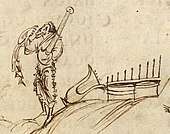
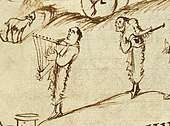

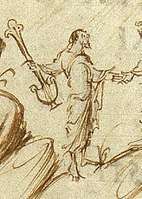 Utrecht Psalter, c. 850 cythara. Quoted text illustrated: "Confitebor tibi in cithara Deus Deus meus" (To thee, O God my God, I will give praise upon the cithara)
Utrecht Psalter, c. 850 cythara. Quoted text illustrated: "Confitebor tibi in cithara Deus Deus meus" (To thee, O God my God, I will give praise upon the cithara)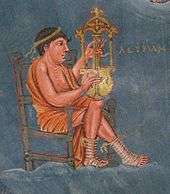 Bible of Charles the Bald, 9th century, cythara as lute or lyre combined, from the Bible of Charles the Bald, 9th century
Bible of Charles the Bald, 9th century, cythara as lute or lyre combined, from the Bible of Charles the Bald, 9th century
Gittern and mandola
Gittern
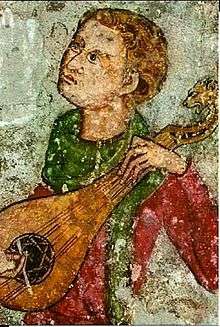
The gittern was a relatively small gut strung round-backed instrument that first appears in literature and pictorial representation during the 13th century in Western Europe (Iberian Peninsula, Italy, France, England). It is usually depicted played with a quill plectrum,[98] as we can see clearly beginning in manuscript illuminations from the thirteenth century. It was also called the guitarra in Spain, guiterne or guiterre in France, the chitarra in Italy and quintern in Germany.[99] A popular instrument with court musicians, minstrels, and amateurs, the gittern is considered ancestral to the modern guitar and possibly to other instruments like the mandore and gallichon.[100]
From the early 16th century, a vihuela shaped (flat-backed) guitarra began to appear in Spain, and later in France, existing alongside the gittern. Although the round-backed instrument appears to have lost ground to the new from which gradually developed into the guitar familiar today, the influence of the earlier style continued. Examples of lutes converted into guitars exist in several museums, while purpose-built instruments like the gallichon utilised the tuning and single string configuration of the modern guitar. A tradition of building round-backed guitars in Germany continued to the 20th century with names like gittar-laute and Wandervogellaute.
Mandola or mandore
The mandore (or mandola in Italian) is a musical instrument, a small member of the lute family, teardrop shaped, with four to six courses of gut strings[101] and pitched in the treble range.[102] It was considered a new instrument in French music books from the 1580s,[103] but is descended from and very similar to the gittern.[100] It is considered ancestral to the modern mandolin. Other earlier instruments include the medieval European citole[104] and the Greek and Byzantine pandura.
The history of modern mandolins, mandolas and guitars are all intertwined.[105] The instruments shared common ancestor instruments.[106] Some instruments became fashionable widely, and others locally. Experts argue as to the differences; because many of the instruments are so similar but not identical, classifying them has proven difficult
The Cantigas de Santa Maria shows 13th century instruments similar to lutes, mandores, mandolas and guitars, being played by European and Islamic players. The instruments moved from Spain northward to France[107] and eastward towards Italy by way of Provence.
Like the earlier gittern, the mandore's back and neck were in earlier forms carved out of a block of wood.[108] This "hollowed out construction" did still exist in the 16th century, according to James Tyler, but was becoming rare.[108] The method was being replaced by gluing curved staves together to form back, and adding a neck and peg box.[108]
Moving toward the acoustic guitar


The modern acoustic guitar comes from a long evolution of stringed musical instruments. It has often been claimed that the guitar is a development of the medieval instrument vihuela as evolution of ancient lute.
Although the word guitar today indicates a specific musical instrument family, centered around the acoustic guitar, in the past it has been used in English about members of the cittern family as well, for example the English guitar and Portuguese guitar.
Further, the ancestor instrument of the citterns, the cytole, came from Spain during the period that one of the ancestors of the guitar, the gittern, was being played. It also has been confused with the Guitarra latina from the early period of instrument development in Spain, and no clear relationship nor distinction has been formed about these guitar ancestors or cousins.
Gitterns, a small plucked guitar were the first small guitar-like instruments created during the spanish Middle Ages with a round back like that of a lute.[109] Modern guitar shaped instruments were not seen until the Renaissance era where the body and size began to take a guitar-like shape.
The earliest string instruments that related to the guitar and its structure where broadly known as the vihuelas within Spanish musical culture. Vihuelas were string instruments that were commonly seen in the 16th century during the Renaissance. Later, Spanish writers distinguished these instruments into two categories of vihuelas. The vihuela de arco was an instrument that mimicked the violin, and the vihuela de penola was played with a plectrum or by hand. When it was played by hand it was known as the vihuela de mano. Vihuela de mano shared extreme similarities with the Renaissance guitar as it used hand movement at the sound hole or sound chamber of the instrument to create music.[110]
By 1790 only six-course vihuela guitars (six unison-tuned pairs of strings) were being created and had become the main type and model of guitar used in Spain. Most of the older 5-course guitars were still in use but were also being modified to a six-coursed acoustical guitar. Fernando Ferandiere's[111] book Arte de tocar la guitarra espanola por musica (Madrid, 1799) describes the standard Spanish guitar from his time as an instrument with seventeen frets and six courses with the first two 'gut' strings tuned in unison called the terceras and the tuning named to 'G' of the two strings. The acoustic guitar at this time began to take the shape familiar in the modern acoustic guitar. The coursed pairs of strings eventually became less common in favor of single strings.[112]
Finally, circa 1850, the form and structure of the modern Guitar is credited to Spanish guitar maker Antonio Torres Jurado, who increased the size of the guitar body, altered its proportions, and invented the breakthrough fan-braced pattern. Bracing, which refers to the internal pattern of wood reinforcements used to secure the guitar's top and back and prevent the instrument from collapsing under tension, is an important factor in how the guitar sounds. Torres' design greatly improved the volume, tone, and projection of the instrument, and it has remained essentially unchanged since.
Citole and cittern
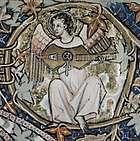

The citole was a string musical instrument, closely associated with the medieval fiddles (viol, vielle, gigue) and commonly used in Europe from 1200–1350.[113][114][115] The earliest representations of the instrument are in sculpture in Spain and Italy, with Spain having the most. Another link to Spain is the similarity to plucked fiddles in the Spanish Beatus Apocalypse manuscripts, such as the Ryland Beatus. Examples of these plucked fiddles trace back to Central Asian art, such as the Airtam Frieze. This artwork is too distant in time to be considered a relative, though it is very similar to many citoles.
The one surviving citole has a hollowed neck, a feature of the rubabs and Coptic lute.
Although it was largely out of use by the late 14th century, the Italians "re-introduced it in modified form" in the 16th century as the cetra (cittern in English), and it was possibly ancestral to the Spanish guitar as well.[116][117][118] Three possible descendant instrument are the English guitar, Waldzither, Portuguese guitar and the Corsican Cetera, all types of cittern.
The cittern or cithren (Fr. cistre, It. cetra, Ger. zitter, zither, Sp. cistro, cedra, cítola)[1] is a stringed instrument dating from the Renaissance. Modern scholars debate its exact history, but it is generally accepted that it is descended from the Medieval citole (or cytole). It looks much like the modern-day flat-back mandolin and the modern Irish bouzouki. Its flat-back design was simpler and cheaper to construct than the lute. It was also easier to play, smaller, less delicate and more portable. Played by all classes, the cittern was a premier instrument of casual music-making much as is the guitar today.
Plucked viols

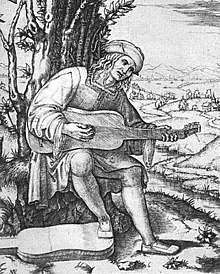
Curt Sachs pointed out that the original meaning of words associated with the fiddle were not words to draw a bow, but to "strike" the strings, pluck them.[120] A Norse fiddler was a "fiddle-striker".[120] In this context, the Italian viola and Spanish vihuela were "guitarlike instruments as well as fiddles". The viol became a bowed instrument, but it was related to the guitar, plucked.
Plucked vihuelas, being essentially flat-backed lutes, evolved in the mid-15th century, in the Kingdom of Aragón, located in north-eastern Iberia (Spain). In Spain, Portugal, and Italy the vihuela was in common use by the late 15th through to the late 16th centuries. In the second half of the 15th century some vihuela players began using a bow, leading to the development of the viol.
There were several different types of vihuela (or different playing methods at least):
- Vihuela de mano: 6 or 5 courses played with the fingers
- Vihuela de penola: played with a plectrum
- Vihuela de arco: played with a bow (ancestor of the viola da gamba)
The vihuela faded away, along with the complex polyphonic music that was its repertoire, in the late 16th century. The vihuela's descendants that are still played are the violas campaniças of Portugal. Much of the vihuela's place, role, and function was taken up by the subsequent Baroque guitar (also sometimes referred to as vihuela or bigüela).
Today, instruments like the tiple are descendants of vihuelas brought to America in the 16th century.
Baroque guitar
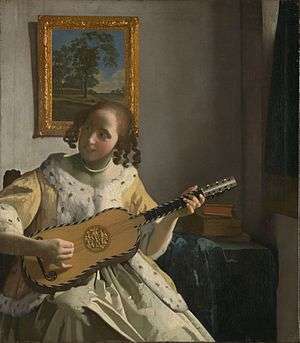
The Baroque guitar (c. 1600–1750) is a string instrument with five courses of gut strings and moveable gut frets. The first (highest pitched) course sometimes used only a single string.[121]
The "Hispano-Italian guitar" was made fashionable in the 17th century by Italian actors, working in Paris.[122] cIt was first an instrument of aristocrats, inspired by the actors, and later it became an amateur instrument.[122]
The Baroque guitar replaced the Renaissance lute as the most common instrument found in the home.[123][124] The earliest attestation of a five-stringed guitar comes from the mid-sixteenth-century Spanish book Declaracion de Instrumentos Musicales by Juan Bermudo, published in 1555.[125] The first treatise published for the Baroque guitar was Guitarra Española de cinco ordenes (The Five-course Spanish Guitar), c. 1590, by Juan Carlos Amat.[126][127] The baroque guitar in contemporary ensembles took on the role of a basso continuo instrument and players would be expected to improvise a chordal accompaniment. Several scholars have assumed that the guitar was used together with another basso continuo instrument playing the bass line.[128] However, there are good reasons to suppose that the guitar was used as an independent instrument for accompaniment in many situations.[129] Intimately tied to the development of the Baroque guitar is the alfabeto system of notation.
Violin family
Spanish and Portuguese descendant lutes in former colonies
Both Spain and Portugal took their instruments with them overseas.
Even after the Muslims were conquered in Spain or driven out, the process of experimentation continued, leading to a number of European instruments, including the guitar. A similar process occurred in Italy. Both Spain and Italy experimented with the viol or vihuela which led to bowed viols, violas vielles, and guitars. Other experiments led to the citole and cittern or Portuguese guitar, the gittern and vandola (mandore, mandola) which also led to the guitar, but also to the mandolin family. Spanish instruments that survived in Spanish colonies include the tiple.
Portuguese experiments led to the Portuguese guitar, and other instruments seen today in places that Portuguese ships landed, including the cavaquinho and ukulele.
A tiple (literally treble or soprano) is a plucked-string chordophone of the guitar family. A tiple player is called a tiplista. The first mention of the tiple comes from musicologist Pablo Minguet e Irol in 1752. David Pelham says of the Colombian tiple: "The tiple is a Colombian adaptation of the Renaissance Spanish vihuela brought to the New World in the 16th century by the Spanish conquistadors. At the end of the 19th century, it evolved to its present shape. Another variant, the tiple Colombiano requinto is often simply called tiple requinto. This instrument is about 10-15% smaller than the tiple Colombiano, and the central octave strings of the larger instrument are tuned in unisions.
In Puerto Rico, the tiple is the smallest of the three string instruments of Puerto Rico that make up the orquesta jibara (i.e., the Cuatro, the Tiple and the Bordonua). According to investigations made by Jose Reyes Zamora, the tiple in Puerto Rico dates back to the 18th century. It is believed to have evolved from the Spanish guitarrillo. There was never a standard for the tiple and as a result there are many variations throughout the island of Puerto Rico. Most tiples have four or five strings and most tiple requintos have three strings. Some tiples have as many as 6 strings and as few as a single string, though these types are rare.
Another instrument from Puerto Rico is the bordonua is said to have evolved from the old 16th century Spanish Acoustic bass guitar called the Bajo de la Una. There were also special melodic Bordonuas that were used during the 1920s and 1930s as accompaniment to melody instead of the bass role. These were oddly tuned like a Tiple. This configuration is no longer used on the island. They are also related to the Spanish renaissance Vihuela, brought to the Island by conquering Spanish.
Mathematics and music
Richard Dumbrill talked about the earliest known systems of musical notes, and what makes them feel natural.[130] He concluded that what makes a mode "feel intrinsic is centuries of usage".[130] For the Sumerians, natural was a five-note system.[130] For the Akkadians, natural was a nine-note system and then a seven-note system, "the basis for our modern [western] system".[130]
With a seeming infinite number of possible pitches to create modes, musicians had to choose which notes to use, and which to play together. One way of bring order to the infinite number of tones was to examine music with mathematics.
The Sumerians and Akkadians, the Greeks, and the Persians all used math to create notes used on lutes and lyres and other stringed instruments. Using the idea that a plucked or bowed string produces a note, they noticed the difference in tone when a string is stopped. "The great discovery" was hearing the double octave, that halving a string produces a note one octave above the string.[131] Written as a ratio 2:1.[131]
They measured the ratios of string lengths on one side and the other of where the string was pressed, creating ratios. Those ratios allowed them to compare sounds, for example third intervals, fourths, fifths. They were able to tune one string against another in those intervals on lutes, lyres, harps, zithers. Lutes gave them the further ability to create those intervals on a single string, by adding frets at mathematically spaced distances, based on the ratios. Unlike modern instruments, where frets may be permanently fixed into the neck, as on a guitar, the older instruments used gut strings tied around the neck for frets, and this made their instruments adjustable. Early musicians could tune their instruments to different modes. Lute players could tune the strings to different intervals, and could further adjust the frets for the modes.
Knowledge passed back and forth between cultures
Western scholarship has traditionally credited the Greeks, including Pythagoras (c. 570 – c. 495 BC), with discovery of this math. However, as modern scholars have looked at cuneiform texts, it is clear that the Greeks were not the first. Recorded thinking in Mesopotamia about the mathematical ratios of strings predates the Greek thinking by at least 1500 years. Furthermore, a form of written music came out of that era, called the Hurrian songs, currently the oldest known written music, and is based on modes of music, created through string ratios. The Persian and Arab thinkers from the Umayyad and Abbssid periods (7th to 13th centuries A.D.), however, did not access this ancient mathematical thinking, but began working with the math again after they accessed Greek thinking.
Thinkers and polymaths of Central Asia and Arabia
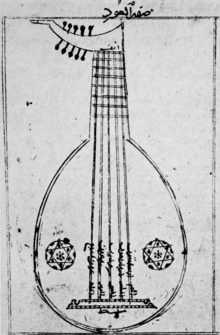
The mixing cultures of Central Asia and Arabia produced several thinkers who wrote about music, including something about the lute in their works, including Al-Kindi (c. 801 – c. 873), Ziryab (789–857), Al-Farabi (c. 872 – c. 950), Avicenna (c. 980 – 1037), and Safi al-Din al-Urmawi (1216–1294). They wrote in Arabic, what had become the useful lingua-Franca of their time, and took part in Muslim society and culture. However they were brought up in Central Asia.
The Arabs had a musical scale, described by al-Farabi, in use by some through the 13th century A.D.[132] That tanbar scale, which divided the string into "40 equal parts" may have been a leftover from Babylon and Assyria.[132] However, the Arabs traded with and conquered the Persians, and they adopted Persian scales for their lutes, just as they adopted Persian short-necked lutes.[132]
Ziryab moved from Baghdad to al-Andalus, where he set up a school of music and was one of the first to add a fifth string or course to oud, "between 822 and 852).[133] Al-Andalus, where he settled would become a center of musical instrument development for Europe.
Al-Kindi was a polymath who wrote as many as 15 music-related treatises. He was among the first to apply Greek musical theory to Central Asian-Arabian short lutes.[133] He added semi-tones between the nut and the first string.[133] He also added a fifth string to his oud in the east, as Ziryab had done in the west.[133]
Al-Farabi "fully incorporated the works of Aristoxenus and Ptolemy into his theory of tetrachords", and wrote among books in many subjects, the Kitab al-Musiqa al-Kabir, the Major Book of Music, in which he detailed how to tune an oud, using mathematical ratios.[134] He gave instruction for both 10 frets and 12, telling where to place the tied (and moveable) gut-string frets on the neck.[134] His way of tuning allowed a "12-fret ‘ud tuning — which results ... 'double-octave' scale", with 22 notes in each octave.[134]
Notes
References
- Sachs, Curt (1940). The History of Musical Instruments. New York: W. W. Norton & Company. p. 464.
- Sachs, Curt (1940). The History of Musical Instruments. New York: W. W. Norton & Company. pp. 82–83.
- Dumbrill 1998, p. 321
- "Trois Freres Cave". Retrieved March 27, 2015.
Henri Breuil surveyed the cave ... a detailed study was published by H.Breuil and R.Begouen of the hundreds of engraved drawings in the deep gallery known as the "Sanctuary".... Its walls are filled with some 280 engraved (often superimposed) images of bison, horses, stags, reindeer, ibexes, and mammoths....
- Garcia, Alfredo (5 October 2014). "El Arte Rupestre Paleolítico En Las Cuevas Francesas. La Cueva De Lascaux". algargosarte.blogspot.com. Archived from the original on 2 September 2018.
[Concerning a pair of images below the text; the top image is a line drawing showing a herd of animals drawn over one another with the hunter and bow in the pack; the other image is a photo of the cave wall with that image, enhanced to show the hunter and animals directly in front of him distinctly:] En Les Trois Frères destacaría su estilo tan naturalista.... Es famosa la escena que del hombre camuflado como un bisonte, ¿Un chamán o un cazador?, que persigue o conduce a otros animales y que he destacado del conjunto superpuesto de abajo. [translation: In Les Trois Frères I would highlight his naturalistic style.... The scene is famous, that of the man camouflaged to resemble a bison, (a shaman or a hunter?), that pursues or leads other animals, and that I have stood out from the set superimposed below....]
- Walter, Eugene Victor (1988). Placeways: A Theory of the Human Environment. Chapel Hill, North Carolina: UNC Press Books. p. 89. ISBN 978-0-8078-1758-2.
a semi-human figure dances in the midst of the animals ... herding the beasts and playing a musical bow. He wears the head and fur of a bison with human legs....
- Campen, Ank van. "The music-bow from prehistory till today". HarpHistory.info. Retrieved March 26, 2015.
A cave-painting in the "Trois Frères" cave in France dating from about 15,000 years ago. The magician-hunter plays the musical bow.
- Dumbrill, 1998 & page 179, 231, 235–236, 308–310
- Sachs, Curt (1940). The History of Musical Instruments. New York: W. W. Norton & Company. pp. 56–57.
- Sachs, Curt (1940). The History of Musical Instruments. New York: W. W. Norton & Company. pp. 136–137.
- Dumbrill, 1998 & page 308–310
- Jahnel, Franz (1965). Manual of Guitar Technology: The History and Technology of Plucked String Instruments (Fachbuchreihe Das Musikinstrument, Bd. 37). p. 15. ISBN 978-0-933224-99-5.
There have been some uncertain presumptions concerning the "invention" of the bowed harp.... The "musical bow" conjectured by many music scholars is not definitely recognizable in any cave paintings. The fact that some African negroes held the end of their bow shaped harp in their mouths in order to improve the tone ... should not be taken as proof that the first European bowmen were also conversant with the musical bow.
- Sachs, Curt (1940). The History of Musical Instruments. New York: W. W. Norton & Company. pp. 255–257.
- Sachs, Curt (1940). The History of Musical Instruments. New York: W. W. Norton & Company. pp. 102–103.
- Dumbrill, Richard J. (2005). The archaeomusicology of the Ancient Near East. Victoria, B.C.: Trafford. pp. 305–310. ISBN 9781412055383. OCLC 62430171.
The long-necked lute would have stemmed from the bow-harp and eventually became the tunbur; and the fat-bodied smaller lute would have evolved into the modern Oud ... the lute pre-dated the lyre which can therefore be considered as a development of the lute, rather than the contrary, as had been thought until quite recently.... Thus the lute not only dates but also locates the transition from musical protoliteracy to musical literacy....
- https://www.britishmuseum.org/research/collection_online/collection_object_details.aspx?objectId=1447477&partId=1&people=24615&peoA=24615-3-17&page=1 British Museum, Cylinder Seal, Culture/period Uruk, Date 3100BC (circa1), Museum number 41632.
- Dumbrill 1998, p. 310
- Dumbrill, Richard J. (2005). The Archaeomusicology of the Ancient Near East. Victoria, British Columbia: Trafford Publishing. pp. 319–320. ISBN 978-1-4120-5538-3.
The long-necked lute in the OED is orthographed as tambura; tambora, tamera, tumboora; tambur(a) and tanpoora. We have an Arabic Õunbur; Persian tanbur; Armenian pandir; Georgian panturi. and a Serbo-Croat tamburitza. The Greeks called it pandura; panduros; phanduros; panduris or pandurion. The Latin is pandura. It is attested as a Nubian instrument in the third century BC. The earliest literary allusion to lutes in Greece comes from Anaxilas in his play The Lyre-maker as 'trichordos'.... According to Pollux, the trichordon (sic) was Assyrian and they gave it the name pandoura.... These instruments survive today in the form of the various Arabian tunbar....
- Turnbull, Harvey (July 1972). "The Origin of the Long-Necked Lute". The Galpin Society Journal. 25: 58–66. doi:10.2307/841337. JSTOR 841337.
- Dumbrill 1998, pp. 321–344
- Sachs, Curt (1940). The History of Musical Instruments. New York: W. W. Norton & Company. pp. 86–87.
- Myers, John E (1992). The Way of the Pipa: Structure and Imagery in Chinese Lute Music. Kent, Ohio: Kent State University Press. p. 11. ISBN 9780873384551.
- Sachs, Curt (1940). The History of Musical Instruments. New York: W. W. Norton & Company. pp. 245–246.
- Farmer, Henry George (1929). A History of Arabian Music. Hertford, Herts: Stephen Austin & Sons, Ltd. p. 102.
- Farmer, Henry George (1929). A History of Arabian Music. Hertford, Herts: Stephen Austin & Sons, Ltd. pp. 3–4, 9–13.
- Sachs, Curt (1940). The History of Musical Instruments. New York: W. W. Norton & Company. pp. 67–68.
- Sachs, Curt (1940). The History of Musical Instruments. New York: W. W. Norton & Company. pp. 82–83.
- Sachs, Curt (1940). The History of Musical Instruments. New York: W. W. Norton & Company. pp. 102–103.
- Scott, Nora E. "The Lute of the Singer Har-Mose" (PDF). The Metropolitan Museum of Art Bulletin: 162. Retrieved 1 September 2018.
- This sarcophagus is at The British Museum: REF. The British Museum says it was uncovered near Rome and was probably made in Rome itself, and date-estimates it 3rd century AD.
- Pestcoe, Schlomo. "Pandoura: The Greco-Roman Lute of Antiquity". shlomomusic.com. Archived from the original on 29 September 2011. Retrieved 29 September 2011.
[see image, top of page] Akin to the Egyptian lutes, the pandoura seen here appears to a hollowed-our wooden body and animal skin head (soundtable), with two lines of small soundholes running parallel on either side of the instrument's stick neck. The conventional wisdom is that the pandoura was a 3-stringed lute, as were the Egyptian lutes. Even more remarkable is the pandoura's triangle-shaped tailpiece, which is also pretty much the same as those found on the Ancient Egyptian lutes.
- Pestcoe, Schlomo. "Pandoura: The Greco-Roman Lute of Antiquity". shlomomusic.com. Archived from the original on 29 September 2011. Retrieved 29 September 2011.
[see image, second from top] The Mantineia Base (c. 330–320 BCE), shows a muse playing a variant of the pandoura with an elongated triangle body. The top of the neck finishes in an inverted triangle as well.
- Pestcoe, Schlomo. "Pandoura: The Greco-Roman Lute of Antiquity". shlomomusic.com. Archived from the original on 29 September 2011. Retrieved 29 September 2011.
[see image, 4th image] Tanagra, Greece (c. 3rd Century BCE). This lute is a small instrument with a narrow pear-shaped body that has a shallow bowl-back.
- Pestcoe, Schlomo. "Pandoura: The Greco-Roman Lute of Antiquity". shlomomusic.com. Archived from the original on 29 September 2011. Retrieved 29 September 2011.
[see 3rd image] Tanagra, Greece (c. 3rd Century BCE) ... one being played by Eros, the terracotta figurine seen on top right from Eretria, Greece (c. 330–200 BCE). Eros' pandoura also has an elongated triangle body.
- Pestcoe, Schlomo. "Pandoura: The Greco-Roman Lute of Antiquity". shlomomusic.com. Archived from the original on 29 September 2011. Retrieved 29 September 2011.
It apparently had somewhat of a disreputable association with frivolity and low merry-making and was considered to be an instrument best suited for the tavern rather than "polite society". Likewise, unlike the lyre, the pandura seems to have been an instrument favored by professional musicians who performed the vernacular "pop" music of the day.
- Rouché, Charlotte. "Aphrodisius in Late Antiquity, Section VIII: Christian prayers and invocations". insaph.kcl.ac.uk. Retrieved 2 September 2018.
VIII.3 Asterius' inscription, 113,.... The profession is among those listed by K. Mentzou, quoting, most revealingly, the life of St Theodoulos the Stylite; when God is testing the saint, he tells him that he will inherit the Kingdom with Cornelius the pandouros from the city of Damascus. 6 Theodoulos is horrified at being associated with a man from the theatre, τοῦ ἀπὸ σκήνης; and he is even more horrified when he goes to Damascus and finds Cornelius at the Hippodrome, holding his instrument with one hand, and with the other, a bareheaded prostitute.
- Scheherezade Qassim Hassan; Morris, R. Conway; Baily, John; During, Jean (2001). "Tanbūr". In Sadie, Stanley; Tyrrell, John (eds.). The New Grove Dictionary of Music and Musicians. xxv (2nd ed.). London: Macmillan. pp. 61–62.
- "تنبور (یا تمبور/ طنبور)". Encyclopaedia Islamica. Archived from the original on June 23, 2013. Retrieved March 3, 2013.
- Jean During, Spirit of Sounds : The Unique Art of Ostad Elahi (1895–1974), Associated University Press, ISBN 978-0-8453-4884-0, ISBN 0-8453-4884-1
- Shiloah, Amnon (2001). "Kurdish music". In Sadie, Stanley; Tyrrell, John (eds.). The New Grove Dictionary of Music and Musicians. xiv (2nd ed.). London: Macmillan. p. 40.
- Scheherezade Qassim Hassan; Morris, R. Conway; Baily, John; During, Jean (2001). "Tanbur". In Sadie, Stanley; Tyrrell, John (eds.). The New Grove Dictionary of Music and Musicians. xxv (2nd ed.). London: Macmillan. pp. 61–62.
- Sachs, Curt (1940). The History of Musical Instruments. New York: W. W. Norton & Company. pp. 255–257.
- Myers, John (1992). The way of the pipa: structure and imagery in Chinese lute music. Kent State University Press. pp. 5–7. ISBN 9780873384551.
- "Sanxian". EasonMusic.
- 楊慎《昇庵外集》:「今次三弦,始於元時」。
- "Sanxian". Encyclopaedia Britannica.
- Leiter, Samuel L. (2007). Encyclopedia of Asian Theatre: A-N. Greenwood Press. p. 445. ISBN 978-0-313-33530-3.
- Kodansha encyclopedia of Japan , Volume 7. 1983. p. 77. ISBN 978-0-87011-627-8.
- "Statues and Reliefs in the Indian Museum, Kolkata". photodharma.net. Retrieved 16 August 2018.
Gandhāra School. The Indian Museum, Calcutta houses the largest collection of Gandhāra Sculptures in India.... The Grey Schist or slate stone sculptures hail mainly from the region lying between Eastern Afghanistan and Northern Pakistan (Peshwar and Rawalpindi districts) and belong to the Gandhāra School which flourished from about the 1st century B.C. to the 6th century A.D. Stucco and teracotta were also used as media from about the 3rd century A.D. The art was at its zenith under the patronage of the Kuṣaṇ kings.... Text adapted from a sign in the Indian Museum
- During, Jean (1988-12-15). "Barbat". Encyclopaedia Iranica. Retrieved 2012-02-04.
- Kasidah. "Pakistan, Swat Valley, Gandhara region Lute Player; From a group of Five Celestial Musicians, 4th-5th century Sculpture; Stone, Gray schist, 10 1/8 x 4 3/4 x 2 1/2 in. (25.7 x 12.1 x 6.4 cm)". Pinterest.com. Retrieved March 25, 2015. Musician playing a 4th-to-5th-Century lute, excavated in Gandhara, and part of a Los Angeles County Art Museum collection of Five Celestial Musicians
- "Bracket with two musicians 100s, Pakistan, Gandhara, probably Butkara in Swat, Kushan Period (1st century – 320)". The Cleveland Museum of Art. Retrieved March 25, 2015.
- Sachs, Curt (1940). The History of Musical Instruments. New York: W. W. Norton & Company. pp. 159–161. ISBN 9780486171517.
- Saxena, Saurabh. "Pawaya – Glamour of the Ancient Padmavati". Retrieved 5 October 2018.
A door lintel from Pawaya in Gujari Mahal Museum
- "Sari: Indian Woman's Globally Venerated Distinction". January 2009.
4th–5th century, Pawaya, now in Gwalior museum Clear closeup of door lintel
- "陕西34件顶级国宝 仅一件就值半个香港 [Only one of the top 34 national treasures in Shaanxi is worth half a Hong Kong]". 28 December 2017. Retrieved 4 October 2018.
Photo of another statuette of camel with musician-riders, bearded foreigers (Sogdian), one with a lute.
- Peony [pseudonym]. "Kuchean Dancers and the Sogdian Whirl". tangdynastytimes.com. Retrieved 15 October 2018.
...Sogdian Whirl ...took the Tang capital by storm. Not only the emperor, but his favorite concubine, the infamous Yang Guifei-- along with her "favorite," the 400 pound Sogdian-Turk An Lushan could perform this exotic dance, snacking on Lychees from Canton and sipping grape wine out of Roman cut glass goblets...Persian melodies, played on Persian lutes and harps, Indian dances and music and those from the Northern steppes and Korea.... the music and dance of Kucha.
- Starr, S. Frecerick (2013). Lost Enlightenment, Central Asia's Golden Age From The Arab Conquest to Tamerlane. Princeton, New Jersey: Princeton University Press. p. 34. ISBN 978-0-691-157733...the Amu Darya (Oxus River) valley in Central Asia constitutes a fourth point of origin of urban civilization, along with the Nile, Indus and Tigris-Euphrates valleys...contacts with all three of these centers of world civilization.
- Starr, S. Frecerick (2013). Lost Enlightenment, Central Asia's Golden Age From The Arab Conquest to Tamerlane. Princeton, New Jersey: Princeton University Press. p. 28. ISBN 978-0-691-157733.
- Starr, S. Frecerick (2013). Lost Enlightenment, Central Asia's Golden Age From The Arab Conquest to Tamerlane. Princeton, New Jersey: Princeton University Press. pp. 45, 48, 61, 96. ISBN 978-0-691-157733in city after city, specialized industries arose to serve the export trade...studied foreign products passing through..identified those they could produce better or cheaper...placed a premium on open-mindedness and innovation...Central Asians were constantly confronted with new way of doing things and new ideas ...they became adept at finding what was useful...they learned how to adapt rather than adopt what they learned from abroad...
- Starr, S. Frecerick (2013). Lost Enlightenment, Central Asia's Golden Age From The Arab Conquest to Tamerlane. Princeton, New Jersey: Princeton University Press. p. 96. ISBN 978-0-691-157733...became skilled at comparison shopping identifying the distinctive elements of each [religion] and also the common denominators among them...the inquiry that formal philosophy calls epistemology..it is not surprising that during the later Age of Enlightenment, Central Asians like Farabi led the world in this field and in the classical logic as well...
- Starr, S. Frecerick (2013). Lost Enlightenment, Central Asia's Golden Age From The Arab Conquest to Tamerlane. Princeton, New Jersey: Princeton University Press. pp. 62–63, 99–100. ISBN 978-0-691-157733, 70
- Starr, S. Frecerick (2013). Lost Enlightenment, Central Asia's Golden Age From The Arab Conquest to Tamerlane. Princeton, New Jersey: Princeton University Press. p. 46. ISBN 978-0-691-157733.
- Peony [pseudonym]. "Kuchean Dancers and the Sogdian Whirl". tangdynastytimes.com. Retrieved 15 October 2018.
[quoting Susan Whitfield's "Life Along the Silk Road]"Music, song and dance," says Whitfield, "were Silk Road commodities, bought and sold like silver and jade. Itinerant dance troops from India, Burma, Cambodia and Sogdiana performed at both the royal court and the public marketplace in every silk road town."
- Starr, S. Frecerick (2013). Lost Enlightenment, Central Asia's Golden Age From The Arab Conquest to Tamerlane. Princeton, New Jersey: Princeton University Press. p. 45. ISBN 978-0-691-157733...four centuries before the Arab invasion, it was the Sogdian merchants from Samarkand, Panjikent and the neighboring towns who stood at the head of European commerce...along the routes to China...all the main routes to India...across the Black Sea to Constantinople, and from Basra in Iraq across Indian Ocean to Sri Lanka and Canton...
- Zhu, Fengsh (September 2014). "墓主燕居行乐图探考 (translation: Exploring Yanjuxing's Tomb". 活力杂志 [Translation: Vitality Magazine]. 黑龙江 [Heilongjiang]: 黑龙江日报报业集团 [Heilongjiang Daily Newspaper Group]. Archived from the original on 24 September 2018. Retrieved 24 September 2018.
[Information about the magazine article this ran in is at www.xueshu.com/hl/201410/3683520.html]
- The pipa: How a barbarian lute became a national symbol Archived 2011-06-13 at the Wayback Machine
- Picken, Laurence (March 1955). "The Origin of the Short Lute". The Galpin Society Journal. 8: 32–42. doi:10.2307/842155. JSTOR 842155.
- "Bracket with two musicians 100s, Pakistan, Gandhara, probably Butkara in Swat, Kushan Period (1st century-320)". The Cleveland Museum of Art. Retrieved March 25, 2015.
- Albert E. Dien (2007). Six Dynasties Civilization. Yale University Press. pp. 342–348. ISBN 978-0-300-07404-8.
- Shen, Sin-Yan (1991). Chinese Music and Orchestration: A Primer on Principles and Practice, p. 109. Chinese Music Society of North America, Woodridge. October 19, 2009.
- 應劭 -《風俗通義·聲音》 Fengsu Tongyi (Common Meanings in Customs) by Ying Shao. Original text: 批把: 謹按: 此近世樂家所作,不知誰也。以手批把,因以為名。長三尺五寸,法天地人與五行,四弦象四時。 Translation: Pipa, made by recent musicians, but maker unknown. Played "pi" and "pa" with the hand, it was thus named. Length of three feet six inches represents the Heaven, Earth, and Man, and the five elements, and the four strings represent the four seasons. (Note that this length of three feet five inches is equivalent to today's length of approximately two feet and seven inches or 0.8 meter.)
- Myers 1992, p. 8.
- Gao, Pat (1 March 2015). "Taiwan Review: Moon Guitar Revival". Taiwan Today. Taiwan: Ministry of Foreign Affairs, Republic of China (Taiwan). Retrieved 1 October 2018.
the guitar-like yueqin ... has been falling out of use due to the rise in popularity of the guitar, piano and various Western orchestral instruments.... Yueqin is a broad term used to describe a number of related instruments that originated in mainland China. The Taiwanese version, which has two strings and a long guitar-like neck, grew out of the merging of several such instruments.... Example of Taiwan yueqin
- "yueqin". Encyclopædia Britannica. Retrieved 26 January 2012.
- 杜佑 《通典》 Tongdian by Du You. Original text: 阮咸,亦秦琵琶也,而項長過於今制,列十有三柱。武太后時,蜀人蒯朗於古墓中得之,晉竹林七賢圖阮咸所彈與此類同,因謂之阮咸。 Translation: Ruan Xian, also called Qin pipa, although its neck was longer than today's instrument. It has 13 frets. During Empress Wu period, Kuailang from Sichuan found one in an ancient tomb. Ruan Xian of The Seven Sages of the Bamboo Grove from the Jin Dynasty was pictured playing this same kind of instrument, it was therefore named after Ruan Xian.
- Shen, Sin-Yan (1991). Chinese Music and Orchestration: A Primer on Principles and Practice, p. 108. Chinese Music Society of North America, Woodridge. October 19, 2009.
- Thrasher, Alan R. (2002). Chinese Musical Instrument, p.40. Oxford University Press Inc., New York. ISBN 0-19-590777-9. October 18, 2009.
- Kersalé Patrick. "Lute - chapei dang veng". soundsofangkor.org/. Retrieved 23 September 2018.
- "Encyclopaedia Iranica – Barbat". Iranicaonline.org. 1988-12-15. Retrieved 2012-02-04.
- Farmer, Henry George (October 1930). "The Origin of the Arabian Lute and Rebec". The Journal of the Royal Asiatic Society of Great Britain and Ireland (4): 769–771. JSTOR 44012873.
- Lu’lu’a, ‘Abdulwāħid (2013). Arabic-Andalusian Poetry and the Rise of the European Love-Lyric. Houston, Texas: Strategic Book Publishing. p. 34. ISBN 9781625164018.
... we read in al-Aghānī that Sā'ib Khāthir was the first person that brought the lute to Madīna after Islām....
- Menocal, María Rosa, Raymond P. Scheindlin, Michael Anthony Sells (eds.) (2000), The Literature of Al-Andalus, Cambridge University PressCS1 maint: multiple names: authors list (link) CS1 maint: extra text: authors list (link)
- Gill, John (2008). Andalucia: A Cultural History. Oxford University Press. p. 81. ISBN 978-01-95-37610-4.
- Lapidus, Ira M. (2002). A History of Islamic Societies. Cambridge University Press. p. 311. ISBN 9780521779333.
- Davila, Carl (2009), Fixing a Misbegotten Biography: Ziryab in the Mediterranean World, Al-Masaq: Islam in the Medieval Mediterranean Vol. 21 No. 2
- "The journeys of Ottoman ouds". oudmigrations. 2016-03-08. Retrieved 2016-04-26.
- Colin Lawson and Robin Stowell, The Cambridge History of Musical Performance, Cambridge University Press, Feb 16, 2012
- Roger Boase, The Origin and Meaning of Courtly Love: A Critical Study of European Scholarship, Manchester University Press, 1977, pp. 70–71.
- Van Edwards, David. "An Illustrated History of the Lute Part One". vanedwards.co.uk.
[image caption:] Byzantine ivory carving (9th–10th century) part of four panels. Hessisches Landesmuseum, Darmstadt No. Kg. SU. 215
- Sachs, Curt (1940). The History of Musical Instruments. New York: W. W. Norton & Company. pp. 251–253.
- Sachs, Curt (1940). The History of Musical Instruments. New York: W. W. Norton & Company. pp. 245.
- Grout, Donald Jay (1962). "Chapter 7: New Currents In The Sixteenth Century". A History Of Western Music. J.M. Dent & Sons Ltd, London. p. 202. ISBN 978-0393937114.
By far the most popular household solo instrument of the Renaissance was the lute
- Sachs, Curt (1940). The History of Musical Instruments. New York: W. W. Norton & Company. p. 464.
... first evidence of a bowed instrument is found in Spanish manuscripts of the tenth and eleventh centuries ... tall, about a man's height ... resembled a bottle with a cork; the lower end was cut off square....
- "Título uniforme [In Apocalipsin] Title Beati in Apocalipsin libri duodecim". bdh.bne.es. Biblioteca Digital Hispánica. Retrieved 10 December 2016.
- Segerman, Ephraim (April 1999). "A Short History of the Cittern". The Galpin Society Journal. 52: 106–107. doi:10.2307/842519. JSTOR 842519.
- P. 118. The Encyclopedia of Music. New York: Hermes House, 2002.
- The Grove Dictionary of Musical Instruments (2nd Edition) (2014). Quinterne [quintern]. doi:10.1093/acref/9780199743391.001.0001. ISBN 9780199743391. Retrieved 2015-03-20.
- Tyler, James (1981). "The Mandore in the 16th and 17th Centuries" (PDF). Early Music (published January 1981). 9 (1): 22–31. doi:10.1093/earlyj/9.1.22. JSTOR 3126587. Retrieved 2013-07-07.
- McDonald 2008, pp. 7–8
- Libin, Laurence (2014). "Mandore [Mandorre]". The Groves Dictionary of Musical Instruments. doi:10.1093/acref/9780199743391.001.0001. ISBN 9780199743391. Retrieved 2015-03-21.
- McDonald 2008, p. 7
- McDonald 2008, pp. 4–8
- McDonald 2008, p. 1
- McDonald 2008, pp. 1–14
- "Mandore Boissart". The Victoria and Albert Museum. Archived from the original on 2011-01-09. Retrieved 2010-11-14.
- Tyler & Sparks 1992, pp. 6–7
- "Gittern". www.medieval-life-and-times.info. Retrieved October 7, 2015.
- Grunfeld, Frederic (1971). The Art and Times of the Guitar. New York City: Macmillan Company. pp. 61–63.
- "Ferandiere, Fernando Archives".
- Tyler, James (2002). The Guitar and its Music. United Kingdom: Oxford University Press. pp. 229–231. ISBN 978 0 19 921477 8.
- Sadie, Stanley, ed. (1984). "Citole". The New Grove Dictionary of Musical Instruments. p. 374. Volume 1.
- "CITOLE, also spelled Systole, Cythole, Gytolle, &c. (probably a Fr. diminutive form of cithara, and not from Lat. cista, a box)" (Chisholm 1911, p. 397)
- Wright 1977, pp. 24, 27–28.
- Wright 1977, p. 32
- Butler, Paul. "The Citole Project". crab.rutgers.edu. Retrieved 16 November 2016.
The citole is definite ancestor of the cittern.
- Galpin, Francis William (1911). Old English Instruments of Music. Chicago: A.C. McClurg and Company. pp. 21–22.
Now it is well known that the Greeks and Romans adopted many of the instruments which they found in popular use throughout Asia Minor ... this instrument with vertical incurved sides and flat back was brought into Southern Europe, the first name given to the Guitar in medieval times being Guitare Latine.... In this way, and popularized by the troubadours and minstrels, the Guitar reached our country in the thirteenth century....
- Batov, Alexander. "Reconstruction of a plucked viola from the painting Madonna and Child with Saints by Veronese artist Girolamo dai Libri (1474–1555)". vihuelademano.com. Retrieved 12 September 2018.
Viola da mano can be regarded as an Italian equivalent to the Spanish vihuela. The most obvious difference between the two seems to be only the shape of their bodies: C-shape cuts with pointed corners on the viola da mano and figure-of-eight body shape on the vihuela.
- Sachs, Curt (1940). The History of Musical Instruments. New York: W. W. Norton & Company. p. 274.
- Harvey Turnbull, The Guitar (From The Renaissance to the Present Day) (3rd impression 1978), London: Batsford (ISBN 0 7134 3251 9), p. 15: "Early lutes, vihuelas and guitars share one important feature that would have been of practical concern to the player; the frets, unlike the fixed metal frets on the modern guitar, were made of gut and tied round the neck" (Chapter 1 - The Development of the Instrument).
- Sachs, Curt (1940). The History of Musical Instruments. New York: W. W. Norton & Company. pp. 374–375.
- Manfred F Bukofzer, Music In The Baroque Era (From Monteverdi to Bach), London: J. M. Dent & Sons (1st UK edition 1948), p. 47: "The Spanish fashion in Italy brought a speedy victory of the nosiy guitar over the dignified lute."
- Donald Jay Grout, A History Of Western Music, London: J. M. Dent & Sons, 1962, Chapter 7: New Currents In The Sixteenth Century, p. 202: "By far the most popular household solo instrument of the Renaissance was the lute."
- Tom and Mary Anne Evans, Guitars: From the Renaissance to Rock, London: Paddington Press, 1977, p. 24: "The first incontrovertible evidence of five-course instruments can be found in Miguel Fuenllana's Orphenica Lyre of 1554, which contains music for a vihuela de cinco ordenes. In the following year Juan Bermudo wrote in his Declaracion de Instrumentos Musicales: 'We have seen a guitar in Spain with five courses of strings.' Bermudo later mentions in the same book that 'Guitars usually have four strings,' which implies that the five-course guitar was of comparatively recent origin, and still something of an oddity."
- Harvey Turnbull, The Guitar (1978), p. 41 (Chapter 3 - The Baroque, Era Of The Five Course Guitar): "The new era is heralded by Juan Carlos Amat's little treatise Guitarra Espanola de cinco ordenes...."
- Evans, Guitars (1977), p. 24: "We know from literary sources that the five course guitar was immensely popular in Spain in the early seventeenth century and was also widely played in France and Italy.... Yet almost all the surviving guitars were built in Italy.... This apparent disparity between the documentary and instrumental evidence can be explained by the fact that, in general, only the more expensively made guitars have been kept as collectors' pieces. During the early seventeenth century the guitar was an instrument of the people of Spain, but was widely played by the Italian aristocracy."
- Manfred F. Bukofzer, Music In The Baroque Era (From Monteverdi to Bach), London: J. M. Dent & Sons (1st UK edition 1948), p. 26: "The basso continuo ... required at least two players, one to sustain the bass line (string bass, or wind instrument) and the other for the chordal accompaniment (keybooard instruments, lute, theorboe, and the popular guitar)."
- Lex Eisenhardt, "Baroque guitar accompaniment: where is the bass". Early Music 42, No 1 (2014) pp. 73–84.
- Dumbrill, 1998 & pages 16–18
- Dumbrill, Richard J (1998). The Archaeomusicology of the Ancient Near East. Tadema Press, London. pp. ii–iiiThis "Foreword", from the second edition, was written by Ernest MacClain, City University, New York. The book title is of second edition. The first edition was entitled 'The Musicology and Organology of the Ancient Near East.'
- Farmer, Henry George (April 1937). "The Lute Scale of Avicenna". The Journal of the Royal Asiatic Society of Great Britain and Ireland (2): 245–246. JSTOR 25201498.
- Farmer, Henry George (April 1937). "The Lute Scale of Avicenna". The Journal of the Royal Asiatic Society of Great Britain and Ireland (2): 247–248. JSTOR 25201498.
- Forster, Christiano M.L. "Musical Mathematics on the art and science of acoustic instruments, Chapter 11". chrysalis-foundation.org. Retrieved 19 September 2018.
Before we continue with Al-Farabi's 12-fret ‘ud tuning — which results in a 22-tone "double-octave" scale ... Al-Farabi concludes 'After these, no note of the ‘ud remains which needs to be reproduced. In each octave, there are twenty-two notes; and these are all the notes used by the ‘ud. Some of them are more frequently used than others.'


